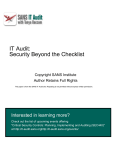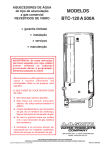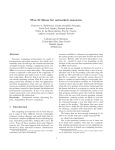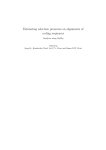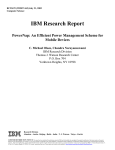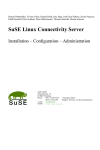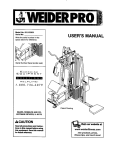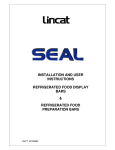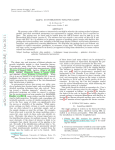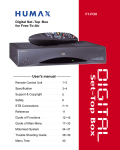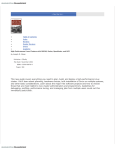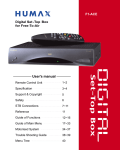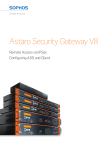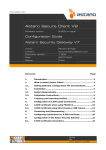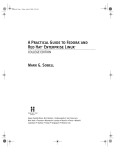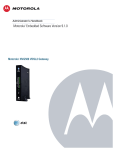Download Auditing the Astaro Secure Linux Firewall: An Evaluation
Transcript
IT Audit:
Security Beyond the Checklist
Copyright SANS Institute
Author Retains Full Rights
This paper is from the SANS IT Audit site. Reposting is not permited without express written permission.
Interested in learning more?
Check out the list of upcoming events offering
"Critical Security Controls: Planning, Implementing and Auditing (SEC440)"
at http://it-audit.sans.orghttp://it-audit.sans.org/events/
fu
ll r
igh
ts.
GIAC GSNA Certification
Auditing Networks, Perimeters, and Systems
ut
ho
rr
eta
ins
GSNA Practical Assignment
Version 3.2
Option 1
04
,A
Auditing the Astaro Secure Linux Firewall: An Evaluation for
Commercial Use
Jeff Groman
January 9, 2005
©
SA
NS
In
sti
tu
te
20
Key fingerprint = AF19 FA27 2F94 998D FDB5 DE3D F8B5 06E4 A169 4E46
© SANS Institute 2004,
As part of GIAC practical repository.
Author retains full rights.
Table of Contents
04
,A
ut
ho
rr
eta
ins
fu
ll r
igh
ts.
INTRODUCTION ................................................................................................................................................... 3
Abstract .......................................................................................................................................................... 3
Description of the Environment .................................................................................................................... 4
Purpose of the Audit ...................................................................................................................................... 5
Scope of the Audit .......................................................................................................................................... 5
VULNERABILITIES, THREATS, IMPACTS, AND RISKS......................................................................................... 6
CURRENT STATE OF PRACTICE ......................................................................................................................... 11
AUDIT CHECKLIST ............................................................................................................................................ 12
AUDIT STEPS..................................................................................................................................................... 12
Hands off Phase ........................................................................................................................................... 12
Hands on Phase ........................................................................................................................................... 14
CONDUCTING THE AUDIT ................................................................................................................................. 32
AUDIT REPORT ................................................................................................................................................. 56
EXECUTIVE SUMMARY ..................................................................................................................................... 56
AUDIT FINDINGS ............................................................................................................................................... 56
AUDIT RECOMMENDATIONS............................................................................................................................. 58
REFERENCES ..................................................................................................................................................... 59
©
SA
NS
In
sti
tu
te
20
Key fingerprint = AF19 FA27 2F94 998D FDB5 DE3D F8B5 06E4 A169 4E46
© SANS Institute 2004,
2
As part of GIAC practical repository.
Author retains full rights.
Introduction
Abstract
fu
ll r
igh
ts.
Historically, it has not been cost effective for the small office to employ a stateful firewall, the only
options being high-end firewall packages or appliances. Lately, however, products have been
introduced that are priced not only for the small business, but are even aimed at the consumer
market. Moreover, with the advent of the Linux 2.4 kernel and IPTables (which replaced the
venerable ipchains), this functionality comes bundled with any Linux distribution.
With that backdrop, this audit addresses a firewall replacement project in a smaller environment
where the current firewall consists of packet filtering on a Cisco 2621 router.
04
,A
ut
ho
rr
eta
ins
The organization has determined that the Astaro firewall package is a good fit since it runs on
inexpensive Intel-based hardware and comes with many add-ons such as virus protection, spam
filtering, and VPN termination, as well as commercial support. However, before purchasing this
product, they want a comprehensive audit done of both the firewall features, and the underlying
OS.
©
SA
NS
In
sti
tu
te
20
Key fingerprint = AF19 FA27 2F94 998D FDB5 DE3D F8B5 06E4 A169 4E46
© SANS Institute 2004,
3
As part of GIAC practical repository.
Author retains full rights.
Description of the Environment
04
,A
ut
ho
rr
eta
ins
fu
ll r
igh
ts.
The firewall to be audited is slated to replace an existing packet screen firewall router, and will
become the primary perimeter defense for the corporate network. It should be noted, however,
that the packet screening router should remain in place in order to maintain “defense in depth”.
The figure below depicts the new environment, while also displaying the devices to be used in the
audit:
©
SA
NS
In
sti
tu
te
20
Key fingerprint = AF19 FA27 2F94 998D FDB5 DE3D F8B5 06E4 A169 4E46
The audit will be performed on a test segment, using test hardware. The following table lists the
devices used in this audit.
Firewall
Sniffer
Victim
Attacker
© SANS Institute 2004,
Make/Model
Dell GX1
Dell GX50
Dell GX1
Mac PowerBook
Processor
Pentium III
Celeron
Pentium II
G4
RAM
128 MB
128 MB
128 MB
1 GB
Drive
6 GB
15 GB
6 GB
60 GB
4
As part of GIAC practical repository.
OS
Astaro Linux 5.0.14
Fedora Core 2
Fedora Core 2
Mac OS X 10.3.4
Author retains full rights.
The firewall should be placed behind the packet screening router, but would still be the primary
perimeter defense. Because of its role, it is critical that the firewall performs as expected, i.e. that
it is configured to match the firewall policy.
Purpose of the Audit
fu
ll r
igh
ts.
Generally, a firewall should control the only entry point (or choke point) into a private network. Its
role must be not only to control what traffic enters the internal network, but also what traffic leaves
the network. That being said, the focus of this audit is to verify that this implementation will do
just that.
ins
A firewall’s ability to control the choke point is based on how it is configured. Therefore, the main
area that this audit focuses on is verifying that the firewall configuration is correct. Additionally, it
is critical that the firewall OS is secure, and that will be verified as well. Though it is reasonable
to expect the firewall to perform as advertised, its performance will also be verified in this audit.
rr
eta
Scope of the Audit
,A
ut
ho
This audit addresses only the firewall configuration (not the antivirus, antispam, vpn, or other
features of the Astaro firewall), and the underlying OS of the platform. Process, policy, and
procedure will be mentioned, but these can be separate audit projects in themselves.
Specifically, the audit will examine the firewall configuration to assess whether it matches the
firewall policy, and determine if the firewall performs as expected.
©
SA
NS
In
sti
tu
te
20
04
The Astaro firewall offers a robust set of features, but these same features can potentially
introduce new vulnerabilities. Therefore, the audit must examine the individual processes
Key
fingerprint
= AF19
FA27
2F94 998D
FDB5any
DE3D
F8B5exposures.
06E4 A169 4E46
running,
and determine
if these
processes
introduce
additional
© SANS Institute 2004,
5
As part of GIAC practical repository.
Author retains full rights.
Vulnerabilities, Threats, Impacts, and Risks
The following table lists the significant vulnerabilities along with a value that describes the relative
likelihood of a threat combining with the vulnerability to cause damage.
Value
High
High
©
SA
NS
In
sti
tu
te
20
04
,A
ut
ho
rr
eta
ins
fu
ll r
igh
ts.
Vulnerabilities
Environmental
Environmental control failure
Physical security
Operational
Network administrator does not properly understand how to configure firewall
Firewall configuration does not match corporate firewall policy.
ACL failure on edge router (defense in depth)
Firewall policy is not in place
Incident Handling procedure is not in place
Logging is not being monitored
Updates to firewall platform do not occur (patching)
Lack of Incident Handling procedure
Lack of Change Management procedure.
Hardware chosen is not sufficient for the traffic and processing load
Hardware fails
Lack of Business Continuity Plan
Backups not being made
Firewall
Firewall does not behave as expected
Firewall management interface (web) passwords weak, can be brute forced
Key
fingerprint
= AF19
FA27 2F94 998D FDB5 DE3D F8B5 06E4 A169
Underlying
Linux
OS
The following is from SANS Top 10 (Unix):
Bind (named)
RPC
Apache (httpd)
Unnecessary user accounts, weak, or no password
Clear Text Services
Sendmail
SNMP
SSH
Misconfiguration of NIS/NFS
OpenSSL
The following is from the Cert Bulletin (June 9-June 22):
Squid Cache Buffer Overflow
Linux Kernel Vulnerability
Syslog-ng not configured for log rotations, etc.
Exim buffer overflow
NTP not being used for logging synchronization
© SANS Institute 2004,
6
As part of GIAC practical repository.
High
High
Med
High
Med
High
High
High
High
High
High
High
Low
High
High
4E46
High
High
High
High
High
High
High
High
High
High
High
High
High
High
Med
Author retains full rights.
The following list shows the possible threats and the likelihood of them occurring. However, the
values do not indicate any possible impacts, just the likelihood of the threats occurring.
Value
Low
High
Low
High
Low
Low
High
High
High
High
Low
Low
rr
eta
ins
fu
ll r
igh
ts.
Threats
Environmental
Fire, flood, or other disaster
Unauthorized access
Firewall hardware failure
Operational
Firewall can be breached (allows traffic through that it should not)
Firewall overtaxed (relative to hardware and traffic loads)
DoS attack directed at firewall
Administrator error
Unscheduled downtime
Attacks being ignored (no one is monitoring the logs).
Logs can not be synchronized, so forensic data will be lost.
Underlying Linux OS
Attacker compromises OS
DoS attack directed at OS
04
Medium
0.5
2F94 998D
0.5 FDB5
50
20
=
Low
0.1
AF19
0.1FA27
10
High
1
DE3D
1 F8B5
100
06E4 A169 4E46
sti
tu
te
Vulnerability
Key Threat
fingerprint
Impact
,A
ut
ho
In order to calculate the risk associated with each vulnerability/threat pair, the NIST Risk
1
Management Guide was referenced. Each risk value was obtained by multiplying the values for
vulnerability, threat, and impact together. The following table shows the values used in the
calculation.
©
SA
NS
In
The table below displays a matrix of vulnerability, threat, impact, and associated risk. Not every
combination of vulnerabilities and threats is valid, so this matrix only shows those pairs that can
lead to pernicious outcomes. The assigned values were derived based on the subject
environment, and the auditor’s experience.
1
United States. Dept. of Commerce. National Institute of Standards and Technology. Risk
Management Guide for Information Technology Systems. Washington: NIST, July 2002. URL:
http://csrc.nist.gov/publications/nistpubs/800-30/sp800-30.pdf
© SANS Institute 2004,
7
As part of GIAC practical repository.
Author retains full rights.
Vulnerability
Lack of
Business
Continuity plan
Vulnerability
Value
Impact
Fire, flood, or
other
disaster
Backups not
being made
Physical
Access
All business
functions would
be down for a
prolonged time.
Threat
Value
Impact
Value
Risk
Value
Risk
1.0
0.1
100.0
10.0
Low
0.1
0.1
100.0
1.0
Low
fu
ll r
igh
ts.
Realizable
Threat
1.0
1.0
100.0
100.0
High
1.0
0.1
50.0
5.0
Low
1.0
0.1
50.0
5.0
Low
ins
1.0
0.1
0.1
50.0
0.5
Low
1.0
1.0
100.0
100.0
High
1.0
1.0
100.0
100.0
High
1.0
1.0
100.0
100.0
High
1.0
1.0
100.0
100.0
High
,A
tu
te
Backups not
being made
High
FDB5 DE3D F8B5 06E4 A169 4E46
20
Key fingerprint = AF19
The availability
of business
FA27critical
2F94systems
998D
and data could
be
compromised.
04
Hardware fails
Firewall
hardware
failure
100.0
ut
Environmental
Controls
100.0
eta
Business
applications
requiring internet
access would be
down.
1.0
rr
Unauthorized
access
ho
User accounts
with weak
passwords
Firewall could be
compromised,
affecting the
confidentiality,
integrity, and
availability of
business critical
systems and
data.
©
Firewall web
interface can
be brute force
attacked.
© SANS Institute 2004,
NS
Firewall does
not match
policy.
Firewall can
be breached
(allows traffic
through that
it should not)
SA
Firewall does
not behave as
expected.
In
sti
Administrator
Error
Internal systems
could be
compromised.
This could
include both
servers and
workstations,
leading to
corruption or
loss of data.
8
As part of GIAC practical repository.
Author retains full rights.
Vulnerability
Value
Impact
Chosen
hardware is
underpowered.
Firewall
overtaxed
(relative to
hardware and
traffic loads)
ACL failure at
edge
DoS attack
directed at
firewall
Impact
Value
Risk
Value
Risk
1.0
0.1
50.0
5.0
Low
0.5
0.1
50.0
2.5
Low
1.0
100.0
100.0
High
1.0
100.0
100.0
High
1.0
100.0
10.0
Low
1.0
1.0
100.0
100.0
High
1.0
1.0
100.0
100.0
High
1.0
1.0
100.0
100.0
High
Firewall could
crash
periodically
affecting
availability of
services.
Logging not
being kept or
monitored
fu
ll r
igh
ts.
Vulnerability
Threat
Value
rr
Realizable
Threat
1.0
Attacks are
being ignored
(no one is
monitoring
the logs).
Logs not
rotated
ins
04
,A
Syslog-ng not
configured
properly
0.1
eta
Logging not
monitored
1.0
ho
Backups not
being made
Attacks could
take place
undetected,
affecting
confidentiality,
integrity, and
availability of
internal systems
and data.
ut
Administrator
error
Firewall
updates not
occurring
Getting to root
cause of
compromises or
attacks may be
impossible
leading to
further incidents.
te
Logs not
synchronized,
so forensic
data will be
lost
NTP not
running
20
Key fingerprint = AF19 FA27 2F94 998D FDB5 DE3D F8B5 06E4 A169 4E46
1.0
50.0
25.0
Med
0.5
0.5
100.0
25.0
Low
1.0
0.5
100.0
50.0
Med
1.0
0.5
100.0
50.0
Med
1.0
0.5
100.0
50.0
Med
1.0
0.5
100.0
50.0
Med
1.0
0.5
100.0
50.0
Med
1.0
0.5
100.0
50.0
Med
1.0
0.5
100.0
50.0
Med
1.0
0.5
100.0
50.0
Med
1.0
0.5
100.0
50.0
Med
OpenSSL
1.0
0.5
100.0
50.0
Med
Squid
1.0
0.5
100.0
50.0
Med
Linux kernel
1.0
0.5
100.0
50.0
Med
In
sti
tu
0.5
NS
ACL failure at
edge
SA
Bind
RPC
Apache
Clear text
services
©
User accounts
Sendmail
SNMP
SSH
NIS/NFS
© SANS Institute 2004,
Attacker
compromises
OS
Firewall is
compromised,
leading to
attacks and
compromising of
internal systems
affecting
confidentiality,
integrity, and
availability of
systems and
data.
9
As part of GIAC practical repository.
Author retains full rights.
Impact
Value
Risk
Value
Risk
0.5
100.0
50.0
Med
0.5
50.0
12.5
Low
1.0
0.5
50.0
25.0
Low
1.0
0.5
50.0
25.0
Low
1.0
0.5
50.0
25.0
Low
1.0
0.5
50.0
25.0
Low
1.0
0.5
50.0
25.0
Low
1.0
0.5
50.0
25.0
Low
1.0
0.5
50.0
25.0
Low
1.0
0.5
50.0
25.0
Low
1.0
0.5
50.0
25.0
Low
1.0
1.0
50.0
50.0
Med
Firewall is
compromised,
leading to
attacks and
compromising of
internal systems
affecting
confidentiality,
integrity, and
availability of
systems and
data.
1.0
ACL failure at
edge
eta
0.5
fu
ll r
igh
ts.
Impact
Attacker
compromises
OS
Exim
Vulnerability
Value
ins
Vulnerability
Threat
Value
rr
Realizable
Threat
Bind
User accounts
DoS attack
directed at
OS
,A
Clear text
services
Firewall could
crash
periodically
affecting
availability of
services.
ut
Apache
ho
RPC
04
Sendmail
SNMP
Key fingerprint = AF19 FA27 2F94 998D FDB5 DE3D F8B5 06E4 A169 4E46
20
NIS/NFS
tu
te
OpenSSL
NS
SA
Unscheduled
Downtime
©
Lack of
Change
Management
procedures
In
sti
Firewall, or a
subset of its
rules, could
impede services
that should be
allowed to
function. This
would affect the
availability of
some or all
services through
the firewall.
© SANS Institute 2004,
10
As part of GIAC practical repository.
Author retains full rights.
Current State of Practice
There are many resources available on the Internet that can help in a firewall implementation and
audit. Below are listed several of these that were used in preparing and performing this audit.
These are some general sites for systems security:
NIST – The National Institute for Standards and Technology has a vast collection of
“Special Publications” that can be found at
http://csrc.nist.gov/publications/nistpubs/index.html. These include several on securing IT
systems, in addition to those dealing with security policy and procedure.
NSA – The National Security Agency has published several guides on securing systems.
These can be found at http://www.nsa.gov/snac/.
CIAC – The Department of Energy maintains an excellent site for its Computer Incident
Advisory Capability. Information can be found regarding new vulnerabilities, bulletins,
and the like. Their home page is found at http ://ciac.org/ciac/index.html.
The German Federal Office for Information Security has published a “Baseline Protection
Manual” which contains a lot of information about securing common IT platforms. It can
be found at http://www.bsi.de/gshb/english/etc/index.htm.
fu
ll r
igh
ts.
•
•
ins
•
rr
eta
•
ho
These are some specific sites for auditing:
OSSTMM – The Institute for Security and Open Methodologies hosts the Open Source
Security Testing Methodology Manual written by Pete Herzog. This can be found at
http://www.isecom.org/osstmm/.
04
Key
ISACA – The Information Systems Audit and Control Association published the IS
Auditing Procedure, Firewalls, Document #6, which is a comprehensive checklist for
fingerprint
= AF19 FA27 2F94 998D FDB5 DE3D F8B5 06E4 A169 4E46
auditing a firewall, and can be found at http://www.isaca.org/standard/procedure7.pdf.
20
•
,A
ut
•
For this audit, the Astaro Security Linux WebAdmin User Manual was invaluable. The
documentation can be found at http://docs.astaro.org/ACM_manuals/.
•
Avishai Wool, an assistant professor at Tel Aviv University published an interesting paper
describing the ways that firewalls are typically misconfigured. This paper can be found at
http://www.eng.tau.ac.il/~yash/computer2004.pdf.
•
There are many examples of firewall audits as well. Some are listed below:
o Auditing Firewalls – Todd Bennett http://www.itsecurity.com/papers/p5.htm
o Auditing Your Firewall Setup – Lance Spitzner http://www.spitzner.net/audit.html
o Auditing a Checkpoint Firewall http://www.giac.org/practical/GSNA/Kevin_Liston_GSNA.pdf
o Auditing an Internet Firewall from an ISO17799 perspective http://www.giac.org/practical/GSNA/Richard_Seiersen_GSNA.pdf
©
SA
NS
In
sti
tu
te
•
More references are mentioned below at each audit step. These include web sites that pertain to
specific vulnerabilities, and technical books that address the topics.
© SANS Institute 2004,
11
As part of GIAC practical repository.
Author retains full rights.
Audit Checklist
The following is a subset of the vulnerabilities listed above. They were chosen based on the
scope of the audit, and the level of risk and significance.
te
20
04
,A
ut
ho
rr
eta
ins
fu
ll r
igh
ts.
Vulnerabilities
Reference No:
Physical access
V1
Administrator knowledge and training
V2
Firewall configuration does not match corporate firewall policy.
V3
Firewall management interface (web) passwords weak, can be brute forced
V4
Bind (named)
V5
RPC
V6
Apache (httpd)
V7
Unnecessary user accounts, weak, or no password
V8
Clear Text Services
V9
Sendmail
V10
SNMP
V11
SSH
V12
Misconfiguration of NIS/NFS
V13
OpenSSL
V14
Squid Cache buffer overflow
V15
Linux kernel vulnerability
V16
Syslog-ng not configured for log rotations, etc.
V17
Exim buffer overflow
V18
Key
= AF19
FA27synchronization
2F94 998D FDB5 DE3D F8B5 06E4 A169 4E46V19
NTPfingerprint
not being used
for logging
sti
Hands-Off Phase
tu
Audit Steps
SA
STEP 1:
NS
In
While all steps in the audit are technical in nature, these first two steps are administrative and
operational. These steps are not actually part of the scope of the audit, but are mentioned here
for completeness.
©
V1: Verify physical access is controlled
Reference:
•
•
© SANS Institute 2004,
Hansche, Susan, Berti, John, and Hare, Chris. Official (ISC)2 Guide to the CISSP Exam.
Boca Raton: Auerbach, 2004. Chapter 7 gives a great overview of what items should
exist on a checklist.
Personal Experience
12
As part of GIAC practical repository.
Author retains full rights.
Risk:
In a computing environment, physical access is tantamount to ownership. Operating systems
allow a user with physical access to shutdown and reset the system, gain access to the operating
system, and sometimes even reset passwords. Thus, it is imperative to maintain strict
procedures for who can access these devices. Moreover, the physical environment must be
secured.
Testing and Compliance:
fu
ll r
igh
ts.
Compliance is based on a checklist including the following:
• Fire suppression
• Surveillance
• Door locks with procedures for handing out and collecting keys
• Door codes with procedures for handing out and changing of codes
• Badge access with procedures for obtaining, activating, and deactivating badges
ins
From physical inspection and interviews, the auditor may find other unique critical items needing
attention.
eta
Test Nature:
rr
Subjective
ho
Evidence:
,A
ut
Findings:
04
STEP 2:
20
Key
AF19 FA27 2F94
998D FDB5
DE3D
F8B5level
06E4 A169 4E46
V2: fingerprint
Evaluate =
administrator
knowledge
and
training
te
Reference:
sti
tu
Personal Experience
In
Risk:
©
SA
NS
Since many service outages are the result of different types of administrator error, it is critical to
ascertain the level of experience and knowledge of the firewall administrator. This shouldn’t be
taken as a personal affront; it is commonplace for a person to be responsible for many distinct
platforms while not being properly trained on all of them. Indeed, it is this auditor’s experience,
for example, that a truly proficient network engineer might not understand how to manage a Linux
firewall.
Compliance/Testing:
This can only be accomplished by interviewing the individual(s) responsible for maintaining the
firewall platform. The following is a short list of questions that need to be asked:
•
•
•
•
© SANS Institute 2004,
Have you received any training on the firewall platform?
What is your background in firewall and ACL configuration?
Who has access to read or modify the firewall configuration?
What is your current procedure for making changes to the firewall rule set?
13
As part of GIAC practical repository.
Author retains full rights.
Is there a procedure for changing the firewall policy before making changes to
the firewall?
o What are the criteria for deciding if the change should be made?
How often are changes made to the firewall?
o
•
Test Nature:
Subjective
fu
ll r
igh
ts.
Evidence:
Findings:
Hands-On Phase
STEP 3:
ins
Preliminary Work:
rr
eta
The audit steps enumerated below will help ensure the viability of the firewall server platform.
However, before going through those steps, it is important to “get a feel” for the server and its
related processes, and derive a baseline of information, all of which can be referred back to later.
ut
ho
In order to do this, the following operations will be conducted, and the results will be recorded in
the next section.
©
SA
NS
In
sti
tu
te
20
Key
04
,A
1. Reboot the server to verify which processes actually start up and run without
intervention.
2. ps ax
fingerprint
= AF19
FA27
998D FDB5
DE3D
06E4but
A169
4E46
• Get
a feel for
what2F94
is running.
The results
areF8B5
ephemeral,
it can
still give
some interesting information.
3. uname -a
• Which Linux kernel is running?
4. top
• Which processes seem to be utilizing the most resources? These results are
also ephemeral, but again they can yield interesting results.
5. cat /etc/passwd
• What types of accounts are present?
6. cat /etc/hosts.equiv
• Are tcp wrappers being used?
7. cat /etc/hosts.allow
• Are rlogin, rsh, etc. configured?
8. rpm -qa > installed-packages.out
• Which packages are installed via rpm?
All of this information should give a sense of what the server does.
Next, a baseline scan of the firewall will be obtained from both the outside and the inside that can
be referred back to during the audit steps. Tools like nmap and nessus will be used to
accomplish this from both the outside and inside interfaces.
© SANS Institute 2004,
14
As part of GIAC practical repository.
Author retains full rights.
From the outside:
nmap -sT -O 10.1.0.2
This will map the ports in use by the firewall, and try to fingerprint the OS from the outside. An
attacker would likely probe similarly. It is important to see what an attacker would see.
From the inside:
fu
ll r
igh
ts.
nmap 10.10.0.1
It is necessary to know which ports are open or in use on the inside of the firewall. Nessus will be
run, using all applicable plugins. (Note: The nessus plugins change frequently, and those
applicable to a Linux firewall can be found in several of the plugin categories. Therefore, it is
recommended to manually go through all applicable categories and check the individual plugins
before starting a scan.)
ins
Evidence:
eta
Findings:
rr
STEP 4:
ut
ho
V3: Firewall configuration doesn’t match corporate firewall policy
,A
Reference:
Netfilter Organization. Documentation found at
http://www.netfilter.org/documentation/index.html.
Key• fingerprint
= AF19
FA27
998D
DE3D
F8B5 06E4
A169
4E46 Feb
Jones, Alan.
“Netfilter
and2F94
IPTables
– AFDB5
Structural
Examination.”
GSEC
Practical,
2004.
• Nemeth, Snyder, Hein. “Linux Administration Handbook.” Prentice Hall PTR, 2002.
Pages 679-683
nd
• Zwicky, Simon, and Chapman. “Building Internet Firewalls.” 2 Edition. O’reilly and
Associates, June 2000. Page 746
sti
tu
te
20
04
•
In
Risk:
©
SA
NS
After the initial firewall configuration is completed, it is imperative that the rule set be compared
with the corporate policy to verify that they match. Furthermore, before any future changes are
made to the firewall, the policy needs to be updated. If the firewall rule set does not match the
policy, then one of two outcomes will result: either the firewall will be blocking that which it should
not, resulting in lack of availability; or, the firewall will not be blocking what it should, risking one
or more compromised systems on the inside, which could result in a lack of confidentiality,
integrity, and/or availability.
Testing and Compliance:
By issuing the following command, a dump of the firewall configuration is redirected into a text
file. The –L (or –list) parameter lists all chains regardless of interface.
iptables -L > fwconfig.txt
© SANS Institute 2004,
15
As part of GIAC practical repository.
Author retains full rights.
This file can then be compared with the firewall policy line by line to verify that implementation
matches policy.
Compliance is based on the output actually matching both what the policy allows and what the
policy denies. However, the auditor cannot merely trust the output of the firewall application. He
needs to test the firewall policy as well. This can be accomplished by placing an “attacking” PC
on the outside, and “victim” and “sniffing” PCs on the inside. The auditor can then test by
scanning across the firewall, and then trying to connect to the victim PC on different ports.
fu
ll r
igh
ts.
The first step will be to probe across the firewall. This will be used as a baseline.
nmap -sP 10.10.0.*
ins
The auditor will also use hping to craft packets to simulate the following attacks:
• Incoming web traffic (made to look like a response)
• FTP data channel being initiated from the internet
• SMTP traffic sent to mail server
• NTP attacks directed at servers
hping 10.10.0.20 -c 1 -s 25 -p 25 -d 100
ut
hping 10.10.0.20 -c 1 -s 123 -p 123 -d 50
ho
rr
hping 10.10.0.50 -c 1 -udp -s 22 -p 17865 -d 500
eta
hping 10.10.0.50 -c 1 –SL -s 80 -p 17865 -d 500
,A
Compliance is based on the firewall behaving as the firewall policy dictates.
04
Test Nature:
Key fingerprint = AF19 FA27 2F94 998D FDB5 DE3D F8B5 06E4 A169 4E46
20
Objective
tu
te
Evidence:
sti
Findings:
In
STEP 5:
•
•
SANS Track 7 Section 7.3 Auditing Web Applications
Belani, Rohyt. “Basic Web Session Impersonation.” Security Focus 14 April 2004. URL:
http://www.securityfocus.com/infocus/1774
Nikto Web CGI Scanning Tool. URL: http://www.cirt.net/code/nikto.shtml
Personal experience
©
•
•
SA
Reference:
NS
V4 Firewall management interface (web) passwords weak, can be broken
Risk:
The web interface is the one portal for configuring all aspects of the firewall. If a brute-force
attack were successful, the firewall would then be compromised, which would lead to servers and
workstations being compromised. The auditor will focus on the web application here, and delve
into the web server application in V7 below.
© SANS Institute 2004,
16
As part of GIAC practical repository.
Author retains full rights.
Testing and Compliance:
fu
ll r
igh
ts.
Two separate categories of tests need to be performed here. The first is scanning of the web
server for cgi vulnerabilities. The second test is to try and brute force attack the login page to
verify that strong passwords are being used for the admin account(s). The cgi scanners used for
this test are nessus and nikto. These were chosen because of their reputations, ease of use, and
functionality. Nessus will be used to check the general configuration of the web server, while
nikto will be utilized with its SSL capabilities to delve further. For brute-force attacking the
passwords themselves, the auditor can use something like Brutus with stunnel, L0phtcrack, or
authforce.
The auditor will concentrate his efforts on the inside interface. He will refer back to the nmap
output obtained in step V3 to determine whether an attack from the outside interface is warranted.
The auditor will also refer back to the nessus scan made earlier.
Nikto will be used as follows:
rr
nikto -h 10.10.0.1 -port 443 -ssl 443 -verbose
eta
ins
Compliance is based on nessus not finding any known vulnerabilities that can be exploited. Only
notices, and possibly warnings should result. All of these will be listed with the findings.
ut
ho
Compliance is based on nikto not finding any critical vulnerabilities. Anything found will be listed
in the findings.
04
,A
The auditor will forgo the brute force attack on the passwords. This is due to the use of weak
passwords in the test environment. However, these passwords need to be changed before
moving the firewall into production, and this test should be performed at that time.
20
Key
fingerprint = AF19 FA27 2F94 998D FDB5 DE3D F8B5 06E4 A169 4E46
Test Nature:
te
Objective
sti
tu
Evidence:
In
Findings:
NS
STEP 6:
•
•
•
•
•
© SANS Institute 2004,
©
Reference:
SA
V5 BIND vulnerabilities
Carnegie Mellon Software Engineering Institute. URL:
http://www.cert.org/nav/index_red.html (Advisories and Incidents)
Internet Software Consortium (writers of BIND). URL:
http://www.isc.org/products/BIND/bind-security.html (additional security issues with BIND)
Nemeth, Snyder, Hein. “Linux Administration Handbook.” Prentice Hall PTR, 2002.
Chapter 16.
SANS Top 10 Unix vulnerabilities. URL: http://www.sans.org/top20/#u1
Personal experience
17
As part of GIAC practical repository.
Author retains full rights.
Risk:
If the BIND version running contains one of the buffer overflow vulnerabilities, and BIND is being
run as root, this can lead to the compromising of the firewall. Thus, the BIND version needs to be
ascertained, and whether it is being run as a different user in a chroot()ed jail.
Testing and Compliance:
fu
ll r
igh
ts.
Determine the version of BIND running:
named -v
Determine where named runs from, who it runs as, and if it is running from a chroot() directory.
ps ax | grep named
grep bin /etc/init.d/named
eta
ins
The auditor should also test if other devices can resolve using this server. He can use the
attacker laptop with nslookup or dig. Ideally, the server will not respond to these types of
requests. This will be done from the inside interface.
rr
The nessus scan will be referred to in order to determine if there were any bind vulnerabilities.
ut
ho
Compliance is based on running version 8.3.7 or later or 8.4.3 or later, and that internal devices
cannot connect to our firewall for the purpose of name resolution. Compliance is not necessarily
based on chroot() being used, but this is still recommended.
04
,A
Test Nature:
20
Objective
Key
fingerprint = AF19 FA27 2F94 998D FDB5 DE3D F8B5 06E4 A169 4E46
te
Evidence:
tu
Findings:
In
sti
STEP 7:
NS
V6 RPC vulnerabilities
SANS Top 10 Unix vulnerabilities. URL: http://www.sans.org/top20/#u2
Garfinkel, Spafford, and Schwartz. “Practical Unix and Internet Security.” O’reilly and
Associates, February, 2003. Chapters 13 and 15.
©
•
•
SA
Reference:
Risk:
Many vulnerabilities exist both in the RPC functions themselves, and in those applications that
use RPC. If one of these vulnerabilities were combined with a threat, the firewall would be
compromised. Moreover, there is no reason for a firewall to run RPC. Its services are not
required for the basic functionality. Therefore, it should be verified that RPC is not running.
© SANS Institute 2004,
18
As part of GIAC practical repository.
Author retains full rights.
Testing and Compliance:
To verify that no RPC services are running, the first step is to check the processes that are
running using ps and netstat:
ps ax | grep rpc
ps ax | grep portmap
netstat -a | grep portmap
ps ax | grep nfs
fu
ll r
igh
ts.
Next, check that inetd or xinetd don’t start RPC services.
cat /etc/inetd.conf
ls /etc/xinetd.d/
Compliance is based on no rpc services being used or turned on.
ins
Test Nature:
eta
Objective
rr
Evidence:
ho
Findings:
04
V7 Apache httpd vulnerabilities
,A
ut
STEP 8:
tu
te
Apache Security (version 1.3). URL: http://www.apacheweek.com/features/security-13
Apache Security (version 2.0). URL: http://www.apacheweek.com/features/security-20
SANS Top 10 Unix vulnerabilities. URL: http://www.sans.org/top20/#u3
sti
•
•
•
20
Reference:
Key
fingerprint = AF19 FA27 2F94 998D FDB5 DE3D F8B5 06E4 A169 4E46
In
Risk:
SA
NS
The Astaro firewall uses the Apache web server to run its web interface. If Apache were
compromised with a buffer overflow that would drop the attacker into a shell as root, this would
lead to the firewall also being compromised. The web application has already been explored for
vulnerabilities in V4. Therefore, the auditor will focus on Apache here.
©
Testing and Compliance:
The first step is to check which version of Apache the Astaro firewall uses:
httpd -v
The most current version as of this writing is 2.0.50, however, new patch versions come out
frequently.
It is also important to know whether httpd is running as root, or as another user.
ps axu | grep httpd
© SANS Institute 2004,
19
As part of GIAC practical repository.
Author retains full rights.
The next step is to test Apache using the nessus vulnerability scanner. The auditor will enable all
Apache plugins.
Compliance is based on running 2.0.50 or later, and/or finding no vulnerabilities. (The reason for
this ambiguity is that it is nearly impossible for a vendor to be at the latest version of Apache
since new versions come out frequently.) While there is no strict requirement for running httpd as
a non-root user, if it is running as root, this will be noted.
fu
ll r
igh
ts.
Test Nature:
Objective
Evidence:
Findings:
ins
STEP 9:
eta
V8 Unnecessary user accounts, weak, or no password
ho
ut
•
SANS Top 10 Unix vulnerabilities. URL: http://www.sans.org/top20/#u4
Garfinkel, Spafford, and Schwartz. “Practical Unix and Internet Security.” O’reilly and
Associates, February, 2003. Chapter 19.
Personal experience
,A
•
•
rr
Reference:
04
Risk:
Key fingerprint = AF19 FA27 2F94 998D FDB5 DE3D F8B5 06E4 A169 4E46
sti
Testing and Compliance:
tu
te
20
User accounts that have either default or no passwords are potentially a direct attack vector.
Thus, all of the accounts that are not being used should be either disabled or deleted, or if they
are required, they should be given strong passwords, and no login access.
NS
In
The first step is to verify which accounts are required, and to identify those that need to be locked
down.
SA
cat /etc/passwd
©
This will also indicate if shadow passwords are being used. If so, the second field in each entry
should only have an asterisk (*) or some other character rather than a hash value.
Those accounts that are required but should never be logged in to should be “login disabled” by
setting their login shells to /bin/false.
All login accounts should have strong passwords.
The difficult part is determining which accounts are required and which are not. Certain accounts,
including uucp and nuucp are almost never used anymore. (UUCP is the Unix to Unix Copy
Protocol, and was originally used in dial-up networks to retrieve mail and news.) Furthermore,
many accounts that are required for services to run do not require a login. These include bin,
sys, daemon, and nobody.
© SANS Institute 2004,
20
As part of GIAC practical repository.
Author retains full rights.
Compliance is based on disabling unnecessary accounts, and verifying passwords comply with
rules of strong passwords.
Test Nature:
Objective
Evidence:
fu
ll r
igh
ts.
Findings:
STEP 10:
V9 Clear text services
Reference:
ins
SANS Top 10 Unix vulnerabilities. URL: http://www.sans.org/top20/#u5
Personal Experience
eta
•
•
rr
Risk:
,A
ut
ho
Clear text services are a high risk because they send login credentials unencrypted. Thus if
someone were sniffing the network using a tool like dsniff, they could obtain the credentials to
compromise the firewall and access the internal network. Since this is a firewall, there is no need
to run services such as ftp and telnet. All of these types of services can be shut off without
affecting the service of the firewall itself.
04
Testing and Compliance:
20
Key fingerprint = AF19 FA27 2F94 998D FDB5 DE3D F8B5 06E4 A169 4E46
sti
tu
te
Since the auditor has already verified that RPC services are shut off (see V9), the focus will shift
to ftp, telnet, http, and smtp. The only service that the firewall may run is the latter, and that only
to send notification alerts to the firewall administrators. It just needs to be verified that this is the
case.
In
First, inetd and xinetd must be checked to see if they are running telnet or ftp.
NS
grep telnet /etc/inetd.conf
grep disable /etc/xinetd.d/telnet
SA
grep ftp /etc/inetd.conf
grep disable /etc/xinetd.d/ftp
©
Second, it must be verified that these daemons are not running independently of the inet
services.
ps ax | grep ftp
ps ax | grep telnet
ps ax | grep rexecd
ps ax | grep rlogind
ps ax | grep rshd
If any of these tests yielded positive results, the appropriate lines in the inet configuration file(s)
need to be commented out, or the daemons disabled directly in the rc.d directory.
© SANS Institute 2004,
21
As part of GIAC practical repository.
Author retains full rights.
As an example, here are two lines from a sample inetd.conf file:
ftp stream tcp nowait root /usr/sbin/ftpd ftpd
ftp stream tcp nowait root /usr/sbin/tcpd in.ftpd
The first line is without tcp wrapper support, and the second is with tcp wrapper support. In order
to disable ftp in this example, just insert a “#” at the beginning of the line to form a comment.
fu
ll r
igh
ts.
Below is an example from an xinetd implementation.
rr
eta
ins
service ftp
{
disable
= yes
socket_type = stream
wait
= no
user
= root
server
= /usr/libexec/ftpd
server_args = -l
groups
= yes
flags
= REUSE IPv6
}
ho
In this example, ftp is disabled from the “disable” line.
04
grep -i listen /etc/httpd.conf
,A
ut
In order to test for http, the host will be scanned to verify it is not listening on those ports (80,
8000, 8080, etc.), and the Apache configuration file will be checked directly. The nmap scan
performed earlier can be referenced.
Key fingerprint = AF19 FA27 2F94 998D FDB5 DE3D F8B5 06E4 A169 4E46
te
20
If httpd is listening for http in addition to https, this needs to be turned off in the httpd.conf file.
(Note that httpd.conf may be located in another location, e.g. /usr/local/httpd/etc.)
sti
tu
Exim needs to be verified that it is configured to only send mail, and not to receive it (see V18
below).
In
Compliance is based on ftp, telnet, and http not running on this system.
Objective
Findings:
©
Evidence:
SA
NS
Test Nature:
STEP 11:
V10 Sendmail vulnerabilities
Reference:
•
•
© SANS Institute 2004,
SANS Top 10 Unix vulnerabilities. URL: http://www.sans.org/top20/#u6
Costales, Bryan and Allman, Eric. “sendmail.” O’reilly and Associates, November 1997.
22
As part of GIAC practical repository.
Author retains full rights.
Risk:
The Astaro firewall should not be running sendmail (since it uses exim), but this needs to be
verified. If it is running, it can be a source of additional exposures.
Testing and Compliance:
First, it needs to be determined if sendmail is running:
fu
ll r
igh
ts.
ps ax | grep sendmail
If sendmail is not running, it needs to be determined whether sendmail is even installed on the
firewall.
rpm -qa | grep sendmail
find / -name sendmail
ins
If it is in fact installed on the server, which version is it?
eta
sendmail -d0.1 < /dev/null | grep -i version
rr
Compliance is based on sendmail running 8.12.10 or later. Preferably, sendmail would not be
installed on the firewall.
ut
ho
Test Nature:
,A
Objective
04
Evidence:
20
Key
fingerprint = AF19 FA27 2F94 998D FDB5 DE3D F8B5 06E4 A169 4E46
Findings:
te
STEP 12
sti
tu
V11 SNMP vulnerabilities
Risk:
NS
SANS Top 10 Unix vulnerabilities. URL: http://www.sans.org/top20/#u7
CERT SNMP Advisory. URL: http://www.cert.org/advisories/CA-2002-03.html
SA
•
•
In
Reference:
©
SNMP agents have become notorious over the last couple of years for being vulnerable to
several types of attacks. Many devices use these agents for network management purposes,
especially for alerting administrators when certain events occur. The concern here is that these
vulnerabilities could be used as an attack vector in order to compromise the firewall.
Testing and Compliance:
Since the Astaro firewall uses SNMP for administrative alerts, it needs to be verified that the
firewall isn’t listening for SNMP messages, but rather only sending traps periodically. The auditor
needs to scan from both interfaces to verify this condition. The nmap scan performed above can
© SANS Institute 2004,
23
As part of GIAC practical repository.
Author retains full rights.
be referenced. The nessus scan will also be referenced to determine if default or easily guessed
community strings are being used.
It must also be determined if snmp traps are being sent using a default community string. The
only way to determine this is to capture the snmp trap packets. A network sniffer such as dsniff
can be used for this task.
dsniff -n -m -w dsniff.out
fu
ll r
igh
ts.
Compliance is based on the firewall not responding to SNMP queries, and the community strings
being something other than the defaults.
Test Nature:
Objective
ins
Evidence:
eta
Findings:
rr
STEP 13:
ho
V12 SSH vulnerabilities
ut
Reference:
SANS Top 10 Unix vulnerabilities. URL: http://www.sans.org/top20/#u8
CERT OpenSSH Challenge Response Handling Vulnerability. URL:
http://www.cert.org/advisories/CA-2002-18.html
Key• fingerprint
= AF19Buffer
FA27Management
2F94 998DVulnerability.
FDB5 DE3D
F8B5 06E4 A169
CERT OpenSSH
URL:
http://www.cert.org/advisories/CA-2003-24.html
• OpenSSH Security Page. URL: www.openssh.org/security.html
4E46
te
20
04
,A
•
•
sti
tu
Risk:
NS
In
The Astaro firewall uses ssh for administrators to access to the server. Since sshd is running, if it
were vulnerable to attack, it would be an easy attack vector to compromise the server. Thus, the
risk is high, and it must be ensured that the version running does not have known vulnerabilities.
SA
Testing and Compliance:
©
The first test is to verify that sshd is running.
ps ax | grep sshd
Next, the version of ssh needs to verified.
ssh -V
Affected versions include 2.3.1p1 through 3.3, with newer vulnerabilities in later versions. As of
this writing, the current version is 3.7.1p2.
Compliance is based on running sshd version 3.7.1p2 or later. If the firewall is running a
vulnerable version, it must be upgraded to a version that includes a fix. In order to ascertain
© SANS Institute 2004,
24
As part of GIAC practical repository.
Author retains full rights.
whether the version is free of vulnerabilities, the references above should be checked. Generally,
the latest version of OpenSSH is preferred.
Test Nature:
Objective
Evidence:
fu
ll r
igh
ts.
Findings:
STEP 14:
V13 Misconfiguration of NIS/NFS
Reference:
ins
SANS Top 10 Unix vulnerabilities. URL: http://www.sans.org/top20/#u9
Nemeth, Snyder, Hein. “Linux Administration Handbook.” Prentice Hall PTR, 2002.
Chapters 17 and 18.
eta
•
•
rr
Risk:
04
,A
ut
ho
Many vulnerabilities in these services have come out over the years including buffer overflows,
DoS, and weak authentication. Any of these could be targeted and exploited by an internal host.
In fact, it could even happen by a misconfigured Unix-like server. Since the firewall has no need
to run either of these services, it needs to be verified that they are turned off, and if possible, not
even installed on the device.
NS
Verify that NFS is off:
In
sti
ps ax | grep ypbind
ps ax | grep ypserv
ps ax | grep nscd
tu
Verify that NIS is off:
te
20
Key
fingerprint
= AF19 FA27 2F94 998D FDB5 DE3D F8B5 06E4 A169 4E46
Testing
and Compliance:
SA
ps ax | grep nfsd
Compliance is based on neither NFS nor NIS running.
©
Test Nature:
Objective
Evidence:
Findings:
© SANS Institute 2004,
25
As part of GIAC practical repository.
Author retains full rights.
STEP 15:
V14 OpenSSL vulnerabilities
Reference:
•
CERT OpenSSL Multiple Vulnerabilities. URL: http://www.cert.org/advisories/CA-200223.html
OpenSSL Security Advisory. URL: http://www.openssl.org/news/secadv_20040317.txt
fu
ll r
igh
ts.
•
Risk:
OpenSSL is a critical component of both the Apache web interface and the ssh interface on the
firewall. Therefore, this is yet another vulnerability that could be exploited to compromise the
firewall, and it is a risk that must be mitigated.
ins
Testing and Compliance:
eta
Test which version is running:
ho
The current version as of this writing is 0.9.7d.
rr
openssl version
04
,A
ut
Compliance is based on running openssl 0.9.7d or later. If the firewall is running a vulnerable
version, it must be upgraded to a version that includes a fix. In order to ascertain whether the
version is free of vulnerabilities, the references above should be checked. Generally, the latest
version of OpenSSL is preferred.
20
Key
fingerprint = AF19 FA27 2F94 998D FDB5 DE3D F8B5 06E4 A169 4E46
Test Nature:
te
Objective
tu
Evidence:
In
sti
Findings:
NS
STEP 16:
•
•
©
Reference:
SA
V15 Squid cache buffer overflow
CIAC Squid NTLM Buffer Overflow. URL: http://www.ciac.org/ciac/bulletins/o-168.shtml
Squid Security Advisory. URL: http://www.squid-cache.org/Advisories/SQUID-2004_2.txt
Risk:
The Astaro firewall uses squid for content filtering, and offers the Windows domain authentication
function as well. Since this vulnerability exists in the NTLM authentication piece, it becomes
imperative to test on the firewall platform. If this feature were enabled on the firewall, it could
potentially result in the firewall being compromised.
© SANS Institute 2004,
26
As part of GIAC practical repository.
Author retains full rights.
Testing and Compliance:
The first step is to verify the version of squid running:
squid -v
If this is a vulnerable version, the next step is to determine if the vulnerable ntlm binary is being
used. This can be determined by checking the squid.conf file.
fu
ll r
igh
ts.
find / -name squid.conf
grep ntlm squid.conf
Squid version 2.5.STABLE5 and earlier are vulnerable. The squid.conf file needs to be checked
for the string 'ntlm_auth'. If it is not being referenced in squid.conf, then the installation is not
vulnerable.
ins
Compliance is based on the firewall running neither a vulnerable version of squid nor the
ntlm.auth binary.
eta
Test Nature:
rr
Objective
ho
Evidence:
ut
Findings:
04
,A
STEP 17:
20
Key
= AF19
FA27 2F94 998D FDB5 DE3D F8B5 06E4 A169 4E46
V16 fingerprint
Linux kernel
vulnerabilities
tu
sti
•
Security Focus: Multiple Linux Kernel Vulnerabilities. URL:
http://www.securityfocus.com/bid/9985
CERT Linux Kernel Vulnerability. URL: http://www.kb.cert.org/vuls/id/301156/
In
•
te
Reference:
NS
Risk:
SA
It goes without saying that if the kernel is vulnerable, at the very least, the firewall could suffer a
DoS attack, or it could be compromised altogether. Thus, this becomes a critical issue.
©
Testing and Compliance:
The only action is to determine which kernel is running:
uname -a
This issue has been resolved as of the 2.4.23 kernel.
Compliance is based on running a kernel version of 2.4.23 or later.
© SANS Institute 2004,
27
As part of GIAC practical repository.
Author retains full rights.
Test Nature:
Objective
Evidence:
Findings:
fu
ll r
igh
ts.
STEP 18:
V17 Syslog-ng not configured for log rotations, etc.
Reference:
ins
Syslog-ng Home Page. URL: http://www.balabit.com/products/syslog_ng/
Syslog-ng FAQ. URL: http://www.campin.net/syslog-ng/faq.html#compression
Configuring syslog-ng. URL: http://sial.org/howto/logging/syslog-ng/
Astaro User manual. URL: http://docs.astaro.org/ACM_manuals/
Personal experience
eta
•
•
•
•
•
rr
Risk:
ut
ho
Log rotation is a double-edged sword. On the one hand, as log files get large, they are difficult to
manage, extract data from, and can even fill up the file system. On the other hand, if the log
rotation overwrites files after a certain period, older logs can get lost.
tu
Testing and Compliance:
te
20
04
,A
A good policy is one that keeps the files to 10MB or so, and deposits older log files into a
separate file system without overwriting older log files. Since this is a firewall, those old logs are
needed; it may be necessary to refer back to them sometime in the future. (Note that 10MB is a
Key
fingerprint = AF19 FA27 2F94 998D FDB5 DE3D F8B5 06E4 A169 4E46
general rule of thumb derived from personal experience. Perl and other script languages can
take a long time to chug through files much larger than 10MB.)
In
sti
Since there are several ways to configure syslog-ng and log rotation in general, it will be
necessary to check the GUI to see how logs are configured, and look at the configuration files on
the server. This can be documented after the fact.
©
SA
NS
Check the syslog-ng.conf file. It should have a directive that rotates logs periodically. Also,
check the user interface, and see how it is configured.
© SANS Institute 2004,
28
As part of GIAC practical repository.
Author retains full rights.
fu
ll r
igh
ts.
ins
eta
rr
ho
ut
,A
04
tu
te
20
Key fingerprint = AF19 FA27 2F94 998D FDB5 DE3D F8B5 06E4 A169 4E46
sti
Figure 1 Log rotation section of Astaro manual
In
Compliance is based on utilizing any means of achieving log rotations and log retention.
SA
Objective
NS
Test Nature:
©
Evidence:
Findings:
© SANS Institute 2004,
29
As part of GIAC practical repository.
Author retains full rights.
STEP 19:
V18 Exim buffer overflow
Reference:
•
Neohapsis Exim Buffer Overflow. URL:
http://archives.neohapsis.com/archives/secunia/2004-q2/0284.html
fu
ll r
igh
ts.
Risk:
ins
The firewall should not be accepting smtp connections from the outside; rather it should only use
the mail server to send messages to the administrators. This fact alone limits the exposure of
any vulnerabilities in the mail transport agent (mta). However, since this is a firewall server, it is
better not to rely solely on the configuration; the firewall should be secure even if the mail
application is misconfigured.
eta
Testing and Compliance:
rr
As of version 4.32, the vulnerability has been fixed. Therefore, the first step is to ascertain which
version our firewall is running.
ho
exim -bV
,A
ut
Furthermore, header syntax checking should also be disabled. First, locate the configuration file:
04
find / -name exim.conf
Oncefingerprint
found, check=two
lines
to see2F94
if they
haveFDB5
been changed
from default
There are
Key
AF19
FA27
998D
DE3D F8B5
06E4 values.
A169 4E46
20
actually two vulnerabilities that have been found in versions prior to 4.32.
sti
The value should be false.
tu
te
grep -i sender_verify exim.conf
In
grep -i headers_check_syntax exim.conf
NS
If the value is header_syntax, then this is exploitable.
SA
It also needs to be determined that exim is only configured to send mail, and not to listen for
incoming mail. Generally, if it is configured to receive mail, it will with the -bd option.
©
Compliance is based on running exim version 4.32 or later, and that header syntax checking is
disabled.
Test Nature:
Objective
Evidence:
Findings:
© SANS Institute 2004,
30
As part of GIAC practical repository.
Author retains full rights.
STEP 20:
V19 NTP not being used for logging synchronization
Reference:
•
•
NTP Man Page
Astaro User Manual. URL: http://docs.astaro.org/ACM_manuals/
fu
ll r
igh
ts.
Risk:
Without the use of a time protocol such as ntp, the various log files that are kept on disparate
systems that make up the modern data center would not be synchronized. Consequently, it
would be very difficult to correlate logs when an incident occurs, or when trying to be proactive.
ins
Testing and Compliance:
The auditor will start by checking to see whether ntp is running on the system:
ut
ho
cat /etc/ntp.conf
rr
Next, he will check to see how ntp is configured:
eta
ps ax | grep ntp
,A
At a minimum, the configuration file should include server directive(s) to point to upstream time
server(s).
04
If ntp is not running, then cron should be checked to see if ntpdate is being run manually. This
20
Key
fingerprint
= AF19the
FA27
2F94
can be
done by checking
crontab
as 998D
root: FDB5 DE3D F8B5 06E4 A169 4E46
te
crontab -l
sti
tu
Compliance will be based on ntp running (either as a daemon, or out of cron), and configured to
synchronize with an outside ntp server.
In
Test Nature:
©
Findings:
SA
Evidence:
NS
Objective
© SANS Institute 2004,
31
As part of GIAC practical repository.
Author retains full rights.
Conducting the Audit
STEP 3:
Preliminary Work:
fu
ll r
igh
ts.
Evidence:
©
SA
NS
In
sti
tu
te
20
04
,A
ut
ho
rr
eta
ins
jeff@astaro:/home/jeff > ps ax
PID TTY
STAT
TIME COMMAND
1 ?
S
0:06 init
2 ?
SW
0:00 [keventd]
3 ?
SWN
0:00 [ksoftirqd_CPU0]
4 ?
SW
0:01 [kswapd]
5 ?
SW
0:00 [bdflush]
6 ?
SW
0:00 [kupdated]
7 ?
SW
0:00 [kinoded]
17 ?
SW
0:00 [kjournald]
62 ?
SW
0:00 [kjournald]
63 ?
SW
0:00 [kjournald]
64 ?
SW
0:00 [kjournald]
65 ?
SW
0:00 [kjournald]
66 ?
SW
0:00 [kjournald]
67 ?
SW
0:00 [kjournald]
196 ?
S
0:11 /sbin/syslog-ng -f /etc/syslog-ng.conf
263 ?
S
0:00 /usr/sbin/cron
362 ?
S
0:02 /usr/bin/dns_resolver 127.0.0.1:16498 /etc/confd/disp
363 ?
S
0:01 /usr/local/bin/alicd -L syslog --daemon --loglevel 2
367 ?
S
0:32 /usr/bin/v4watcher 127.0.0.1:16498 /etc/confd/dispatc
371 ?
S
21:25 /usr/bin/confd 127.0.0.1:16498 /etc/confd/dispatcher.
408 ?
S
0:01 /usr/sbin/httpd -f /etc/httpd/httpd.conf
524 ?
S
1:13 /var/mdw/mdw_daemon.pl
555 ?
S
2:34 /usr/local/bin/selfmonng.pl
556 ?
S
0:00 /usr/local/bin/daemon-watcher selfmonng.pl /usr/local
Key
FA27
2F94
998D FDB5 DE3D F8B5 06E4 A169 4E46
557fingerprint
tty1
S = AF19
0:00
login
-- root
558 tty2
S
0:00 /sbin/mingetty --no-hostname tty2
559 tty3
S
0:00 /sbin/mingetty --no-hostname tty3
560 tty4
S
0:00 /sbin/mingetty --no-hostname tty4
561 ?
S
0:00 /var/aua/aua.bin /etc/wfe/conf/aua_main_config.ini
595 tty1
S
0:00 -bash
604 ?
S
0:00 /usr/sbin/sshd -4 -f /etc/ssh/sshd_config
756 ?
S
0:00 /bin/logger -t httpd -p local6.notice
766 ?
S
0:00 /usr/sbin/fcgi- -f /etc/httpd/httpd.conf
883 ?
S
0:00 /usr/bin/hyperdyper
.
.
.
944 ?
S
0:00 /usr/bin/hyperdyper
955 ?
S
0:00 /sbin/squidf -sYD
962 ?
S
0:01 (squid) -sYD
968 ?
S
0:00 (unlinkd)
969 ?
S
0:00 syslogger squid_access
970 ?
S
0:00 /usr/sbin/localhttpd -f /etc/httpd/httpd-loopback.con
982 ?
S
0:00 /usr/sbin/localhttpd -f /etc/httpd/httpd-loopback.con
983 ?
S
0:00 /usr/sbin/localhttpd -f /etc/httpd/httpd-loopback.con
985 ?
S
0:00 /usr/sbin/localhttpd -f /etc/httpd/httpd-loopback.con
998 ?
S
0:00 /usr/bin/weed 127.0.0.1:16464 /etc/weed/weed.xml
999 ?
S
0:00 /usr/bin/weed 127.0.0.1:16464 /etc/weed/weed.xml
1005 ?
S
0:00 /usr/bin/weed 127.0.0.1:16464 /etc/weed/weed.xml
2288 ?
S
0:00 /usr/bin/perl /usr/local/bin/sarg-logger.pl -f blocke
2289 ?
S
0:00 /usr/bin/perl /usr/local/bin/sarg-logger.pl -f access
2290 ?
S
0:00 /usr/bin/perl /usr/local/bin/reporter/vpn-reporter.pl
2291 ?
S
0:01 /usr/bin/perl /usr/local/bin/reporter/ips-reporter.pl
2295 ?
S
0:01 /usr/bin/perl /usr/local/bin/reporter/cfilter-reporte
2296 ?
S
0:15 /usr/bin/perl /usr/local/bin/reporter/pfilter-reporte
2297 ?
S
0:00 /usr/bin/perl /usr/local/bin/reporter/socks-reporter.
2298 ?
S
0:00 /usr/bin/perl /usr/local/bin/reporter/smtp-reporter.p
© SANS Institute 2004,
32
As part of GIAC practical repository.
Author retains full rights.
2299 ?
S
0:01
2300 ?
S
0:01
2321 ?
S
0:00
4140 ?
Z
0:00
4241 ?
S
0:06
4511 ?
S
0:33
4514 ?
S
0:23
4732 ?
S
0:00
4734 ?
S
0:00
4735 pts/0
S
0:00
4864 pts/0
R
0:00
jeff@astaro:/home/jeff >
/usr/bin/perl /usr/local/bin/reporter/admin-reporter.
/usr/bin/perl /usr/local/bin/notifier.pl
/bin/exim -bd -q20m
[aua.bin] <defunct>
/var/wfe/index.fpl
/usr/sbin/httpd -f /etc/httpd/httpd.conf
/usr/sbin/httpd -f /etc/httpd/httpd.conf
/usr/sbin/sshd -4 -f /etc/ssh/sshd_config
/usr/sbin/sshd -4 -f /etc/ssh/sshd_config
-bash
ps ax
fu
ll r
igh
ts.
Figure 2 Output from “ps ax”
jeff@astaro:/home/jeff > uname -a
Linux astaro.mycompany.com 2.4.21-21503-default #1 Wed May 5 15:40:13 UTC 2004 i686
unknown
04
,A
ut
ho
rr
eta
ins
Figure 3 Output from “uname –a”
©
SA
NS
In
sti
tu
te
20
Key fingerprint = AF19 FA27 2F94 998D FDB5 DE3D F8B5 06E4 A169 4E46
Figure 4 Output from “top”
© SANS Institute 2004,
33
As part of GIAC practical repository.
Author retains full rights.
fu
ll r
igh
ts.
jeff@astaro:/home/jeff > cat /etc/passwd
root:x:0:0:root:/root:/bin/bash
bin:x:1:1:bin:/bin:/bin/bash
daemon:x:2:2:Daemon:/sbin:/bin/bash
uucp:x:10:14:Unix-to-Unix CoPy system:/etc/uucp:/bin/bash
wwwrun:x:30:65534:WWW daemon apache:/var/lib/wwwrun:/bin/bash
nobody:x:65534:65533:nobody:/var/lib/nobody:/bin/bash
sshd:x:71:65:SSH daemon:/var/lib/sshd:/bin/false
ntp:x:74:65534:NTP daemon:/var/lib/ntp:/bin/false
loginuser:x:100:100:remote login user:/home/login:/bin/bash
chroot:x:666:666:chroot user:/var:/bin/false
jeff:x:667:100::/home/jeff:/bin/bash
jeff@astaro:/home/jeff >
Figure 5 Contents of “/etc/passwd”
Output from “cat /etc/hosts.equiv”:
ho
Figure 6 Contents of “/etc/hosts.equiv”
rr
eta
ins
jeff@astaro:/home/jeff > cat /etc/hosts.equiv
#
# hosts.equiv
This file describes the names of the hosts which are
#
to be considered "equivalent", i.e. which are to be
#
trusted enough for allowing rsh(1) commands.
#
# hostname
04
,A
ut
jeff@astaro:/home/jeff > cat /etc/hosts.deny
# /etc/hosts.deny
# See `man tcpd? and `man 5 hosts_access? as well as /etc/hosts.allow
# for a detailed description.
http-rman : ALL EXCEPT LOCAL
Key fingerprint = AF19 FA27 2F94 998D FDB5 DE3D F8B5 06E4 A169 4E46
te
20
Figure 7 Contents of "/etc/hosts.deny"
©
SA
NS
In
sti
tu
jeff@astaro:/home/jeff > cat /etc/hosts.allow
# /etc/hosts.allow
# See `man tcpd? and `man 5 hosts_access? for a detailed description
# of /etc/hosts.allow and /etc/hosts.deny.
#
# short overview about daemons and servers that are built with
# tcp_wrappers support:
#
# package name |
daemon path
|
token
# ---------------------------------------------------------------------------# ssh, openssh | /usr/sbin/sshd
| sshd, sshd-fwd-x11, sshd-fwd-<port>
# quota
| /usr/sbin/rpc.rquotad | rquotad
# tftpd
| /usr/sbin/in.tftpd
| in.tftpd
# portmap
| /sbin/portmap
| portmap
#
The portmapper does not verify against hostnames
#
to prevent hangs. It only checks non-local addresses.
#
# (kernel nfs server)
# nfs-utils
| /usr/sbin/rpc.mountd | mountd
# nfs-utils
| /sbin/rpc.statd
| statd
#
# (unfsd, userspace nfs server)
# nfs-server
| /usr/sbin/rpc.mountd | rpc.mountd
# nfs-server
| /usr/sbin/rpc.ugidd | rpc.ugidd
#
# (printing services)
# lprng
| /usr/sbin/lpd
| lpd
# cups
| /usr/sbin/cupsd
| cupsd
#
The cupsd server daemon reports to the cups
© SANS Institute 2004,
34
As part of GIAC practical repository.
Author retains full rights.
error logs, not to the syslog(3) facility.
All of the other network servers such as samba, apache or X, have their own
access control scheme that should be used instead.
In addition to the services above, the services that are started on request
by inetd or xinetd use tcpd to "wrap" the network connection. tcpd uses
the last component of the server pathname as a token to match a service in
/etc/hosts.{allow,deny}. See the file /etc/inetd.conf for the token names.
The following examples work when uncommented:
fu
ll r
igh
ts.
Example 1: Fire up a mail to the admin if a connection to the printer daemon
has been made from host foo.bar.com, but simply deny all others:
lpd : foo.bar.com : spawn /bin/echo "%h printer access" | \
mail -s "tcp_wrappers on %H" root
ins
Example 2: grant access from local net, reject with message from elsewhere.
in.telnetd : ALL EXCEPT LOCAL : ALLOW
in.telnetd : ALL : \
twist /bin/echo -e "\n\raccess from %h declined.\n\rGo away.";sleep 2
rr
eta
Example 3: run a different instance of rsyncd if the connection comes
from network 172.20.0.0/24, but regular for others:
rsyncd : 172.20.0.0/255.255.255.0 : twist /usr/local/sbin/my_rsyncd-script
rsyncd : ALL : ALLOW
jeff@astaro:/home/jeff >
,A
04
jeff@astaro:/home/jeff > rpm -qa
filesystem-2002.9.2-5608
glibc-2.2.5-21301
attr-2.4.2-5501
Key
fingerprint = AF19 FA27 2F94
acl-2.0.19-7601
fileutils-4.1.11-10701
ncurses-5.2-40202
readline-4.3-5301
bash-2.05b-5301
fillup-1.10-3201
gdbm-1.8.0-68901
binutils-2.12.90.0.15-5001
bzip2-1.0.2-5101
popt-1.6-35601
zlib-1.1.4-5101
diffutils-2.8.1-4901
e2fsprogs-1.34-38
file-3.37-20601
findutils-4.1.7-43501
gawk-3.1.1-32701
grep-2.5.1-8401
iputils-ss020124-45701
iptables-1.2.9-7
joe-2.9.8-13001
less-376-3101
modutils-2.4.25-5301
net-tools-1.60-45501
nacctd-0.71-4
netcat-1.10-61201
netdiag-20010114-13901
recode-3.6-24001
sash-3.4-50401
sed-3.02.80-5301
devs-2002.10.4-901
sysvinit-2.82-36401
tar-1.13.25-4601
textutils-2.1-3901
ut
Figure 8 Contents of “/etc/hosts.allow”
ho
#
#
#
#
#
#
#
#
#
#
#
#
#
#
#
#
#
#
#
#
#
#
#
#
#
#
#
#
#
©
SA
NS
In
sti
tu
te
20
998D FDB5 DE3D F8B5 06E4 A169 4E46
© SANS Institute 2004,
35
As part of GIAC practical repository.
Author retains full rights.
fu
ll r
igh
ts.
ins
eta
rr
ho
ut
,A
04
20
2F94 998D FDB5 DE3D F8B5 06E4 A169 4E46
©
SA
NS
In
sti
tu
te
zip-2.3-49001
timezone-2.2.5-21301
terminfo-5.2-40202
gzip-1.3-32601
libgcc-3.2.2-3801
libstdc++-3.2.2-3801
db-4.0.14-19401
iproute2-2.4.7-49501
g3utils-1.1.28-25402
mgetty-1.1.28-25402
cracklib-2.7-71601
pam-0.76-10901
libxcrypt-1.1-5401
sh-utils-2.0-37702
sudo-1.6.6-5101
vlan-1.6-7401
libcap-1.92-22601
perl-5.8.0-11501
perl-XML-Parser-2.31-4001
perl-XML-Simple-1.08-4301
perl-Unix-Syslog-0.98-2601
perl-MIME-Lite-2.117-2601
perl-MIME-Types-0.16-6801
perl-HTML-Tagset-3.03-30001
perl-HTML-Parser-3.26-3901
lilo-22.3.2-5701
gpg-1.0.7-9401
openssl-0.9.6g-11401
heimdal-lib-0.4e-20701
cyrus-sasl-1.5.27-28001
openldap2-client-2.1.4-7001
shadow-4.0.2-36502
vim-6.1-19401
aaa_base-2003.3.27-5504
ash-0.2-64101
util-linux-2.11u-9502
mktemp-1.5-48201
k_deflt-2.4.21-21503
kbd-1.06-16901
openssh-3.4p1-26301
Key
fingerprint = AF19 FA27
ps-2003.10.7-101
pam-modules-2002.8.29-1201
xntp-4.1.1-28902
rpm-3.0.6-55401
expat-1.95.4-4101
pcre-3.9-13101
libpcap-0.7.1-17601
tcpdump-3.7.1-35101
netcfg-2002.9.4-1301
logrotate-3.5.9-19801
ncftp-3.1.3-5601
cron-3.0.1-83901
hwinfo-5.62-101
gmp-4.0-14901
rrdtool-1.0.39-5701
des-4.04b-51801
rsync-2.5.5-13701
hdparm-5.2-3301
freetype2-2.0.9-8701
libxml2-2.5.11-121
xmlwrapp-0.4.1-13
libxslt-1.0.26-12
apache2-2.0.49-31
syslog-ng-1.6.0rc4-21
ez-ipupdate-3.0-5
perl-Mail-SpamAssassin-2.63-6
spamassassin-2.63-6
smbclient-3.0.1-4
sarg-1.4.1-2
pcmcia-cs-3.2.7-4
wireless_tools-26-1
hostap-0.1.2-2
tools-5.0-8
© SANS Institute 2004,
36
As part of GIAC practical repository.
Author retains full rights.
fu
ll r
igh
ts.
ins
eta
rr
ho
ut
,A
04
chroot-bind-5.0-20
chroot-dhcpc-5.0-20
dhcpcd-1.3.22pl1-12901
chroot-dhcps-5.0-19
dhcp-chroot-server-3.0.1rc9-4301
chroot-http-5.0-21
chroot-ident-5.0-16
chroot-ipsec-5.0-33
chroot-kav-5.0-13
kaspersky-5.0.1.0-19
chroot-pop3-5.0-24
chroot-ppp-5.0-23
chroot-pppoe-5.0-26
chroot-pptp-5.0-20
chroot-pptpc-5.0-18
chroot-smtp-5.0-32
chroot-snmp-5.0-19
net-snmp-5.1-101
chroot-snort-5.0-23
chroot-socks-5.0-16
chroot-squid-2.5-23
chroot-weed-5.0-26
ep-docs-5.0-16
ep-licd-5.0-19
ep-init-texts-5.0-3
ep-libs-5.0-25
ep-wool-1.0-313
ep-confd-1.0-414
ep-confd-helpers-5.0-274
ep-chroot-squid-5.0-25
ep-webadmin-external-helpers-5.0-93
ep-webadmin-helpers-5.0-95
ep-notifier-db-5.0-12
ep-backupconverter-5.0-23
ep-webadmin-pics-5.0-86
ep-webadmin-5.0-113
ep-license-tools-5.0-12
ep-tools-5.0-48
ep-up2date-pattern-5.0-3
ep-hyperdyper-0.1-304
Key
fingerprint = AF19 FA27 2F94
ep-up2date-system-5.0-3
ep-syslog-ng-5.0-38
ep-logging-5.0-45
ep-notifier-5.0-43
ep-reporting-5.0-50
ep-pcmcia-5.0-17
ep-ha-5.0-43
ep-sarg-5.0-4
ep-lcd-5.0-7
ep-webadmin-log-helpers-5.0-7
ep-localpics-5.0-3
ep-chroot-bind-5.0-21
ep-chroot-dhcpc-5.0-17
ep-chroot-dhcps-5.0-17
ep-chroot-ident-5.0-18
ep-chroot-ipsec-5.0-28
ep-chroot-ppp-5.0-20
ep-chroot-pppoe-5.0-24
ep-chroot-pptp-5.0-22
ep-chroot-pptpc-5.0-19
ep-chroot-smtp-5.0-21
ep-chroot-snort-5.0-28
ep-chroot-socks-5.0-17
ep-weed-http-0.3-347
ep-weed-pop3-0.3-347
ep-weed-smtp-0.3-347
ep-up2date-5.0-60
ep-wool-pop3-1.0-324
ep-wool-smtp-1.0-324
ep-wool-weed-1.0-324
ep-mrpopper-1.1-112
ep-capwrapper-1-4
ep-contentfilter-templates-5.0-5
©
SA
NS
In
sti
tu
te
20
998D FDB5 DE3D F8B5 06E4 A169 4E46
© SANS Institute 2004,
37
As part of GIAC practical repository.
Author retains full rights.
fu
ll r
igh
ts.
ep-defaults-5.0-48
ep-defaults-kaspersky-5.0-10
ep-confd-default-config-5.0-3
ep-bootsplash-5.0-6
ep-aua-5.0-36
ep-init-5.0-63
ep-mdw-5.0-103
ep-selfmon-5.0-42
ep-webadmin-lang-us-5.0-88
ep-weed-0.3-347
ep-wool-http-1.0-324
ep-wool-squid-1.0-324
jeff@astaro:/home/jeff >
Figure 9 Output from “rpm –qa”
$ sudo nmap -sT -O 10.1.0.2
ho
rr
eta
ins
Starting nmap 3.50 ( http://www.insecure.org/nmap/ ) at 2004-09-19 11:57 EDT
Warning: OS detection will be MUCH less reliable because we did not find at lea
st 1 open and 1 closed TCP port
Interesting ports on 10.1.0.2:
(The 1658 ports scanned but not shown below are in state: filtered)
PORT
STATE SERVICE
443/tcp open https
Device type: general purpose
Running: Linux 2.4.X
OS details: Linux Kernel 2.4.19 - 2.4.20
Uptime 0.055 days (since Sun Sep 19 10:39:44 2004)
Nmap run completed -- 1 IP address (1 host up) scanned in 76.507 seconds
04
,A
ut
Figure 10 Running “nmap” from the outside
©
SA
NS
In
sti
tu
te
20
Key fingerprint = AF19 FA27 2F94 998D FDB5 DE3D F8B5 06E4 A169 4E46
© SANS Institute 2004,
38
As part of GIAC practical repository.
Author retains full rights.
$ sudo nmap 10.10.0.1
Starting nmap 3.50 ( http://www.insecure.org/nmap/ ) at 2004-09-19 14:06 EDT
Interesting ports on 10.10.0.1:
(The 1656 ports scanned but not shown below are in state: filtered)
PORT
STATE SERVICE
22/tcp open
ssh
53/tcp closed domain
443/tcp open
https
fu
ll r
igh
ts.
Nmap run completed -- 1 IP address (1 host up) scanned in 68.881 seconds
Figure 11 Running “nmap” from the inside
Nessus Scan Report
1
Number of security warnings found
3
rr
Number of security holes found
ho
1
04
,A
ut
Hosts which where alive and responding
during test
eta
Scan Details
ins
This report gives details on hosts that were tested and issues that were found. Please follow the recommended
steps and procedures to eradicate these threats.
Host List
20
Key
fingerprint = AF19 FA27 2F94
998D FDB5 DE3D F8B5 06E4 A169 4E46
Host(s)
Possible Issue
Security hole(s) found
te
10.10.0.1
In
sti
tu
[ return to top ]
Analysis of Host
Port/Service
Issue regarding
Port
10.10.0.1
ssh (22/tcp)
Security hole found
general/udp
Security notes found
general/tcp
Security notes found
© SANS Institute 2004,
SA
10.10.0.1
©
10.10.0.1
NS
Address of
Host
39
As part of GIAC practical repository.
Author retains full rights.
Security Issues and Fixes: 10.10.0.1
Type
Port
Issue and Fix
Vulnerability
ssh
(22/tcp)
You are running a version of OpenSSH which is older than 3.7.1
fu
ll r
igh
ts.
Versions older than 3.7.1 are vulnerable to a flaw in the buffer management
functions which might allow an attacker to execute arbitrary commands on
this
host.
An exploit for this issue is rumored to exist.
ins
Note that several distribution patched this hole without changing
the version number of OpenSSH. Since Nessus solely relied on the
banner of the remote SSH server to perform this check, this might
be a false positive.
ut
ho
rr
Returns :
openssh-server-3.1p1-13 (RedHat 7.x)
openssh-server-3.4p1-7 (RedHat 8.0)
openssh-server-3.5p1-11 (RedHat 9)
eta
If you are running a RedHat host, make sure that the command :
rpm -q openssh-server
ssh
(22/tcp)
You are running OpenSSH-portable 3.6.1p1 or older.
tu
Warning
te
20
Key fingerprint =
04
,A
Solution : Upgrade to OpenSSH 3.7.1
See also : http://marc.theaimsgroup.com/?l=openbsdmisc&m=106375452423794&w=2
http://marc.theaimsgroup.com/?l=openbsd-misc&m=106375456923804&w=2
Risk factor : High
AF19
FA27 2F94 998D FDB5 DE3D F8B5 06E4 A169 4E46
CVE : CAN-2003-0682, CAN-2003-0693, CAN-2003-0695
BID : 8628
Nessus ID : 11837
©
SA
NS
In
sti
If PAM support is enabled, an attacker may use a flaw in this version
to determine the existence or a given login name by comparing the times
the remote sshd daemon takes to refuse a bad password for a non-existent
login compared to the time it takes to refuse a bad password for a
valid login.
An attacker may use this flaw to set up a brute force attack against
the remote host.
*** Nessus did not check whether the remote SSH daemon is actually
*** using PAM or not, so this might be a false positive
Solution : Upgrade to OpenSSH-portable 3.6.1p2 or newer
Risk Factor : Low
CVE : CAN-2003-0190
BID : 7342, 7467, 7482
Nessus ID : 11574
Warning
ssh
(22/tcp)
The remote SSH daemon supports connections made
using the version 1.33 and/or 1.5 of the SSH protocol.
These protocols are not completely cryptographically
safe so they should not be used.
Solution :
If you use OpenSSH, set the option 'Protocol' to '2'
40 'Ssh1Compatibility' to 'no'
If you use SSH.com's set the option
© SANS Institute 2004,
As part of GIAC practical repository.
Risk factor : Low
Nessus ID : 10882
Author retains full rights.
safe so they should not be used.
Solution :
If you use OpenSSH, set the option 'Protocol' to '2'
If you use SSH.com's set the option 'Ssh1Compatibility' to 'no'
Risk factor : Low
Nessus ID : 10882
Warning
ssh
(22/tcp)
You are running OpenSSH-portable 3.6.1 or older.
fu
ll r
igh
ts.
There is a flaw in this version which may allow an attacker to
bypass the access controls set by the administrator of this server.
OpenSSH features a mechanism which can restrict the list of
hosts a given user can log from by specifying a pattern
in the user key file (ie: *.mynetwork.com would let a user
connect only from the local network).
eta
ins
However there is a flaw in the way OpenSSH does reverse DNS lookups.
If an attacker configures his DNS server to send a numeric IP address
when a reverse lookup is performed, he may be able to circumvent
this mechanism.
ho
rr
Solution : Upgrade to OpenSSH 3.6.2 when it comes out
Risk Factor : Low
CVE : CAN-2003-0386
BID : 7831
Nessus ID : 11712
An ssh server is running on this port
Nessus ID : 10330
Informational ssh
(22/tcp)
Remote SSH version : SSH-1.99-OpenSSH_3.4p1
04
,A
ut
Informational ssh
(22/tcp)
Nessus ID : 10267
Key fingerprint = AF19
FA27 2F94 998D FDB5 DE3D F8B5 06E4 A169 4E46
tu
1.33
1.5
1.99
2.0
In
.
.
.
.
te
20
The remote SSH daemon supports the following versions of the
SSH protocol :
sti
Informational ssh
(22/tcp)
SA
NS
SSHv1 host key fingerprint :
92:36:49:b5:ec:c6:bd:39:a9:39:3e:e6:dd:5d:21:28
SSHv2 host key fingerprint : 5c:c7:8d:7e:87:00:6f:3b:0f:22:f7:ce:0d:36:0a:ea
Nessus ID : 10881
©
Informational general/udp For your information, here is the traceroute to 10.10.0.1 :
10.10.0.100
?
10.10.0.1
Nessus ID : 10287
Informational general/tcp
Remote OS guess : Linux Kernel 2.4.0 - 2.5.20
CVE : CAN-1999-0454
Nessus ID : 11268
This file was generated by Nessus, the open-sourced security scanner.
© SANS Institute 2004,
41
As part of GIAC practical repository.
Author retains full rights.
Figure 12 Results of nessus scan
Findings:
Many packages have been installed in a chroot() environment, and tcp wrappers is installed as
well. But the most significant find is an ssh vulnerability found by nessus. This will be expanded
upon below.
STEP 4:
fu
ll r
igh
ts.
V3 Firewall configuration does not match corporate firewall policy
While working with the client, it was learned that no firewall policy exists. The auditor came up
with a “boiler-plate” policy that the client could take and customize later. The following list shows
the generic firewall policy.
Ports allowed:
o Inside network, Outbound: WWW, ICMP echo request, FTP, DNS, NTP (for 2
servers), SMTP (from the mail server)
o Inside network, Inbound: SMTP (to the mail server)
o Packet filtering done at edge router:
Block Inbound: RFC 1918, Multicast, Bogon, NetBios, SNMP, spoofed
private addresses, destination of firewall DMZ interface IP
Block Outbound: RFC 1918, NetBios, SNMP, source of firewall DMZ
interface IP
Firewall not accessible to internet (only DMZ interface may have public address)
Procedures for updating the firewall rules, and moving them into production
Procedures for updating firewall software
ut
04
,A
•
•
•
ho
rr
eta
ins
•
©
SA
NS
In
sti
tu
te
20
Key fingerprint = AF19 FA27 2F94 998D FDB5 DE3D F8B5 06E4 A169 4E46
© SANS Institute 2004,
42
As part of GIAC practical repository.
Author retains full rights.
Firewall rules translated to the client’s network:
Destination
Any
Any
Any
Any
Any
Any
Any
10.10.0.20/32
Any
Ports
80, 8000, 8080, 443
22
ICMP Echo request
DNS lookup
Any
123
25
25
Any
Evidence:
iptables -L
DROP)
source
anywhere
anywhere
all -- anywhere
anywhere
-- anywhere
anywhere
anywhere
anywhere
ins
destination
anywhere
anywhere
anywhere
anywhere
anywhere
anywhere
anywhere
anywhere
rr
eta
state RELATED,ESTABLISHED
ho
astaro:/home/jeff #
Chain INPUT (policy
target
prot opt
ACCEPT
all -ACCEPT
all -SPOOFING_PROTECTION
HA
all -SANITY_CHECKS all
AUTO_INPUT all -USR_INPUT all -LOGDROP
all --
Action
Allow
Allow
Allow
Allow
Deny
Allow
Allow
Allow
Deny
fu
ll r
igh
ts.
Source
10.10.0.128/25
10.10.0.128/25
10.10.0.128/25
10.10.0.128/25
10.10.0.128/25
10.10.0.0/25
10.10.0.20/32
Any
Any
In
sti
tu
te
Chain OUTPUT (policy DROP)
target
prot opt source
ACCEPT
all -- anywhere
ACCEPT
all -- anywhere
HA
all -- anywhere
SANITY_CHECKS all -- anywhere
AUTO_OUTPUT all -- anywhere
USR_OUTPUT all -- anywhere
LOGDROP
all -- anywhere
20
04
,A
ut
Chain FORWARD (policy DROP)
target
prot opt source
destination
ACCEPT
all -- anywhere
anywhere
state RELATED,ESTABLISHED
SPOOFING_PROTECTION all -- anywhere
anywhere
SANITY_CHECKS all -- anywhere
anywhere
AUTO_FORWARD all -- anywhere
anywhere
USR_FORWARD all -- anywhere
anywhere
Key
fingerprint
= AF19
FA27 2F94 998D
FDB5 DE3D F8B5 06E4 A169 4E46
LOGDROP
all -anywhere
anywhere
SA
NS
Chain AUTO_FORWARD (1 references)
target
prot opt source
ACCEPT
icmp -- anywhere
©
Chain AUTO_INPUT (1
target
prot opt
ACCEPT
tcp -dpt:ssh
LOGDROP
tcp -dpt:ssh
ACCEPT
tcp -dpt:https
LOGDROP
tcp -dpt:https
ACCEPT
tcp -dpt:domain
ACCEPT
udp -dpt:domain
ACCEPT
tcp -dpt:http-alt
ACCEPT
icmp --
© SANS Institute 2004,
destination
anywhere
anywhere
anywhere
anywhere
anywhere
anywhere
anywhere
state RELATED,ESTABLISHED
destination
anywhere
references)
source
10.10.0.0/24
destination
anywhere
tcp spts:tcpmux:65535
anywhere
anywhere
tcp spts:tcpmux:65535
anywhere
anywhere
tcp spts:1024:65535
anywhere
anywhere
tcp spts:1024:65535
10.10.0.0/24
anywhere
tcp spts:domain:65535
10.10.0.0/24
anywhere
udp spts:domain:65535
astaro.mycompany.com
anywhere
anywhere
tcp spts:tcpmux:65535
anywhere
43
As part of GIAC practical repository.
Author retains full rights.
LOGDROP
dpt:smtp
ACCEPT
tcp
--
anywhere
anywhere
tcp spts:tcpmux:65535
udp
--
10.10.0.10
anywhere
udp spts:1024:65535 dpt:snmp
In
sti
tu
te
20
04
,A
ut
ho
rr
eta
ins
fu
ll r
igh
ts.
Chain AUTO_OUTPUT (1 references)
target
prot opt source
destination
ACCEPT
tcp -- anywhere
10.1.0.10
tcp spts:domain:65535
dpt:domain OWNER CMD match named
ACCEPT
udp -- anywhere
10.1.0.10
OWNER CMD match named udp
spts:domain:65535 dpt:domain
ACCEPT
tcp -- anywhere
anywhere
tcp spts:1024:65535 dpt:http
OWNER CMD match squidf
ACCEPT
tcp -- anywhere
anywhere
tcp spts:1024:65535 dpt:http
OWNER CMD match hyperdyper
ACCEPT
tcp -- anywhere
anywhere
tcp spts:1024:65535
dpt:https OWNER CMD match squidf
ACCEPT
tcp -- anywhere
anywhere
tcp spts:1024:65535
dpt:https OWNER CMD match hyperdyper
ACCEPT
tcp -- anywhere
anywhere
tcp spts:1024:65535 dpt:ftp
OWNER CMD match squidf
ACCEPT
tcp -- anywhere
anywhere
tcp spts:1024:65535 dpt:ftp
OWNER CMD match hyperdyper
ACCEPT
tcp -- anywhere
anywhere
tcp spts:1024:65535
dpt:http-alt OWNER CMD match squidf
ACCEPT
tcp -- anywhere
anywhere
tcp spts:1024:65535
dpt:http-alt OWNER CMD match hyperdyper
ACCEPT
tcp -- anywhere
anywhere
tcp spts:1024:65535 dpt:ldap
OWNER CMD match squidf
ACCEPT
tcp -- anywhere
anywhere
tcp spts:1024:65535 dpt:ldap
OWNER CMD match hyperdyper
ACCEPT
tcp -- anywhere
anywhere
tcp spts:1024:65535 dpt:x11
OWNER CMD match weed
ACCEPT
udp -- anywhere
anywhere
OWNER CMD match net
select udp spts:1024:65535 dpts:33000:34000
ACCEPT
icmp -- anywhere
anywhere
icmp type 8 code 0
ACCEPT
tcp -- anywhere
anywhere
tcp spts:tcpmux:65535
dpt:smtp OWNER CMD match exim
ACCEPT
udp -- anywhere
astaro.mycompany.com OWNER CMD match syslog-ng
udp spts:1024:65535 dpt:syslog
ACCEPT
tcp -- anywhere
anywhere
tcp spts:tcpmux:65535
Key
fingerprint
= AF19 FA27 2F94 998D
FDB5 DE3D F8B5
06E4 A169 4E46
dpt:https OWNER CMD match aus
ACCEPT
tcp -- anywhere
anywhere
tcp spts:tcpmux:65535
dpt:http OWNER CMD match aus
ACCEPT
tcp -- anywhere
anywhere
tcp spts:tcpmux:65535
dpt:https OWNER CMD match pattern_aus
ACCEPT
tcp -- anywhere
anywhere
tcp spts:tcpmux:65535
dpt:http OWNER CMD match pattern_aus
ACCEPT
udp -- anywhere
anywhere
OWNER CMD match net
select udp spts:1024:65535 dpts:33000:34000
ACCEPT
udp -- anywhere
10.1.0.10
udp spts:1024:65535 dpt:ntp
NS
Chain HA (2 references)
target
prot opt source
destination
©
SA
Chain INVALID_PKT (0 references)
target
prot opt source
LOG
all -- anywhere
`INVALID_PKT: '
DROP
all -- anywhere
Chain LOGACCEPT
target
prot
LOG
all
`ACCEPT: '
ACCEPT
all
destination
anywhere
anywhere
(0 references)
opt source
-- anywhere
destination
anywhere
--
anywhere
anywhere
Chain LOGDROP (6 references)
target
prot opt source
LOG
all -- anywhere
'
DROP
all -- anywhere
LOG level info prefix
destination
anywhere
LOG level info prefix
LOG level info prefix `DROP:
anywhere
Chain LOGREJECT (1 references)
© SANS Institute 2004,
44
As part of GIAC practical repository.
Author retains full rights.
target
prot opt source
LOG
all -- anywhere
`REJECT: '
REJECT
all -- anywhere
unreachable
Chain SANITY_CHECKS (3 references)
target
prot opt source
SYNRATE_LIMIT tcp -- anywhere
flags:SYN,RST,ACK/SYN
SYNRATE_LIMIT udp -- anywhere
destination
anywhere
LOG level info prefix
anywhere
reject-with icmp-port-
destination
anywhere
tcp
anywhere
references)
source
anywhere
destination
anywhere
anywhere
anywhere
Chain STRICT_TCP_STATE (0 references)
target
prot opt source
eta
destination
LOG level info prefix `IP-
ins
Chain SPOOF_DROP (4
target
prot opt
LOG
all -SPOOFING DROP: '
DROP
all --
fu
ll r
igh
ts.
Chain SPOOFING_PROTECTION (2 references)
target
prot opt source
destination
SPOOF_DROP all -- astaro.mycompany.com anywhere
SPOOF_DROP all -- 10.1.0.0/24
anywhere
SPOOF_DROP all -- astaro.mycompany.com anywhere
SPOOF_DROP all -- 10.10.0.0/24
anywhere
04
,A
ut
ho
rr
Chain SYNRATE_LIMIT (2 references)
target
prot opt source
destination
RETURN
tcp -- anywhere
anywhere
limit: avg 100/sec burst 30
mode srcip-dstip htable-size 0 htable-max 0 htable-gcinterval 1000 htable-expire 10000
RETURN
udp -- anywhere
anywhere
limit: avg 100/sec burst 30
mode srcip-dstip htable-size 0 htable-max 0 htable-gcinterval 1000 htable-expire 10000
LOG
tcp -- anywhere
anywhere
LOG level info prefix
`SYNRATE_LIMIT: '
LOG
udp -- anywhere
anywhere
LOG level info prefix
`SYNRATE_LIMIT: '
DROP
tcp -- anywhere
anywhere
DROP
udp -- anywhere
anywhere
20
Key fingerprint = AF19 FA27 2F94 998D FDB5 DE3D F8B5 06E4 A169 4E46
©
SA
NS
In
sti
tu
te
Chain USR_FORWARD (1 references)
target
prot opt source
ACCEPT
tcp -- 10.10.0.128/25
ACCEPT
tcp -- 10.10.0.128/25
dpt:irdmi
ACCEPT
tcp -- 10.10.0.128/25
dpt:http-alt
ACCEPT
tcp -- 10.10.0.128/25
dpt:https
ACCEPT
tcp -- 10.10.0.128/25
dpts:ftp-data:ftp
ACCEPT
tcp -- 10.10.0.128/25
dpt:domain
ACCEPT
udp -- 10.10.0.128/25
dpt:domain
ACCEPT
icmp -- 10.10.0.128/25
REJECT
all -- 10.10.0.128/25
unreachable
ACCEPT
udp -- 10.10.0.10
ACCEPT
udp -- 10.10.0.20
ACCEPT
tcp -- anywhere
dpt:smtp
ACCEPT
icmp -- anywhere
LOGREJECT icmp -- anywhere
Chain USR_INPUT (1 references)
target
prot opt source
Chain USR_OUTPUT (1 references)
target
prot opt source
astaro:/home/jeff #
© SANS Institute 2004,
destination
anywhere
anywhere
tcp spts:1024:65535 dpt:http
tcp spts:1024:65535
anywhere
tcp spts:1024:65535
anywhere
tcp spts:1024:65535
anywhere
tcp spts:1024:65535
anywhere
tcp spts:tcpmux:65535
anywhere
udp spts:tcpmux:65535
anywhere
anywhere
icmp type 8 code 0
reject-with icmp-port-
anywhere
anywhere
10.10.0.20
udp spt:ntp dpt:ntp
udp spt:ntp dpt:ntp
tcp spts:tcpmux:65535
anywhere
anywhere
icmp type 0 code 0
icmp type 0 code 0
destination
destination
45
As part of GIAC practical repository.
Author retains full rights.
Figure 13 Output from IPTables
The firewall rules that were entered appear under the USR_FORWARD chain. These do match
the basic policy outlined in the table above. The rules for managing the firewall via ssh, https,
and snmp can be found under the AUTO_INPUT rule. It is also apparent that in addition to the
firewall rules that were entered, the firewall has its own default settings, like controlling tcp syn
rates, not allowing spoofed addresses, and settings for logging.
$ sudo nmap -sP 10.10.0.*
fu
ll r
igh
ts.
Starting nmap 3.50 ( http://www.insecure.org/nmap/ ) at 2004-09-19 12:08 EDT
Host 10.10.0.1 appears to be up.
Nmap run completed -- 256 IP addresses (1 host up) scanned in 6.662 seconds
Figure 14 Output from nmap probe of the inside network from the outside
This scan reveals little information, which indicates that the firewall is doing its job.
eta
ins
$ sudo hping 10.10.0.50 -c 1 -j -V -s 80 -p 17865 -d
500
using en0, addr: 10.1.0.5, MTU: 1500
HPING 10.10.0.50 (en0 10.10.0.50): NO FLAGS are set, 40 headers + 500 data bytes
ho
rr
--- 10.10.0.50 hping statistic --1 packets tramitted, 0 packets received, 100% packet loss
round-trip min/avg/max = 0.0/0.0/0.0 ms
04
--- 10.10.0.20 hping statistic ---
,A
ut
$ sudo hping 10.10.0.20 -c 1 -j -V -s 25 -p 25 -d 50
0
using en0, addr: 10.1.0.5, MTU: 1500
HPING 10.10.0.20 (en0 10.10.0.20): NO FLAGS are set, 40 headers + 500 data bytes
1 packets
tramitted,
0 packets
100%
packet
loss F8B5 06E4 A169 4E46
Key
fingerprint
= AF19
FA27 received,
2F94 998D
FDB5
DE3D
te
Figure 15 Output from hping
20
round-trip min/avg/max = 0.0/0.0/0.0 ms
©
SA
NS
In
sti
tu
It is not clear whether these packets actually got through or not. True, there was no response,
but that does not tell the entire story. Below is a portion of the packet capture which shows that
the smtp packets did go through. However, the other hping attempts do not show up on the sniff.
Therefore, the firewall seems to be acting as it is expected to.
© SANS Institute 2004,
46
As part of GIAC practical repository.
Author retains full rights.
fu
ll r
igh
ts.
ins
eta
rr
ho
,A
ut
Figure 16 Ethereal packet capture
te
20
04
Findings:
The output from iptables indicates that the firewall is configured correctly. However, this had to
be tested
empirically
as well.
The2F94
output998D
from nmap
hping,F8B5
correlated
our4E46
sniffing box
Key
fingerprint
= AF19
FA27
FDB5and
DE3D
06E4with
A169
running ethereal proves that at least for the tests that were run, the firewall is behaving as
expected.
In
sti
tu
Referring back to the nmap scan ran above, the web interface is listening on both Ethernet
interfaces. This should be shut off on the external interface. The Astaro firewall web interface
provides a method for doing just that. It also provides a feature to block an IP that tries to brute
force attack the password to login.
NS
PASS
SA
STEP 5:
©
V4 Firewall management interface
Evidence:
--------------------------------------------------------------------------- Nikto 1.32/1.27
www.cirt.net
V: - Testing open ports for web servers
V: - Checking for HTTP on port 10.10.0.1:443
V: - Checking for HTTPS on port 10.10.0.1:443
+ Target IP:
10.10.0.1
+ Target Hostname: 10.10.0.1
+ Target Port:
443
--------------------------------------------------------------------------+ SSL Info:
Ciphers: EDH-RSA-DES-CBC3-SHA
Info:
/C=DE/ST=BW/L=Karlsruhe/O=Astaro AG/CN=firewall.doma
© SANS Institute 2004,
47
As part of GIAC practical repository.
Author retains full rights.
fu
ll r
igh
ts.
in.example/[email protected]
Subject: /C=DE/ST=BW/L=Karlsruhe/O=Astaro AG/CN=firewall.doma
in.example/[email protected]
+ Start Time:
Sun Sep 19 13:15:55 2004
--------------------------------------------------------------------------- Scan is dependent on "Server" string which can be faked, use -g to override
+ Server: Apache
+ No CGI Directories found (use '-C all' to force check all possible dirs)
V: - Checking for CGI in:
V: - Server category identified as 'apache', if this is not correct please use g to force a generic scan.
V: - 1832 server checks loaded
V: - 200 for GET:
/
.
.
.
V: - 404 for GET:
/zentrack/index.php
+ 1832 items checked - 1 item(s) found on remote host(s)
+ End Time:
Sun Sep 19 13:22:04 2004 (369 seconds)
--------------------------------------------------------------------------+ 1 host(s) tested
ins
Figure 17 Output from nikto
rr
eta
Findings:
As mentioned above, the brute force attack against the administrator’s password was not
attempted. This step is critical, and needs to be performed later. That being said, the output from
nikto showed no vulnerabilities or issues with the web application.
ut
ho
As mentioned above, the firewall web interface is accessible via the outside interface (refer to
figure 10 above). This needs to be turned off in the firewall configuration.
,A
PASS
20
04
STEP 6:
Key fingerprint = AF19 FA27 2F94 998D FDB5 DE3D F8B5 06E4 A169 4E46
V5 Bind
tu
te
Evidence:
In
sti
The bind binary, named, was not found in a usual location (/sbin, or /usr/sbin). It appears that it
has been placed in a chroot()ed jail.
NS
jeff@astaro:/home/jeff > /var/chroot-bind/usr/sbin/named -v
named 8.4.4 Wed Mar 31 18:47:49 CEST 2004
SA
Figure 18 Output from named –V
©
The firewall is running bind 8.4.4.
jeff@astaro:/home/jeff > ps ax | grep named
4763 pts/0
R
0:00 grep named
jeff@astaro:/home/jeff >
Figure 19 Is bind running?
Named is not running, but found in /var/chroot-bind/usr/bin/named
Furthermore, when nslookup was pointed to use the firewall as its server, it just times out. This is
confirmed by the nmap output above, which shows that the port was closed (see figure 11).
In addition, nessus found no vulnerabilities (see figure 12 above.)
© SANS Institute 2004,
48
As part of GIAC practical repository.
Author retains full rights.
Findings:
The firewall is running BIND version 8.4.4, which is a compliant version in the version 8 code
train.
PASS
Step 8:
fu
ll r
igh
ts.
V7 Apache
Evidence:
jeff@astaro:/home/jeff > /usr/sbin/httpd -v
Server version: Apache/2.0.49
Figure 20 Apache version
0:01 /usr/sbin/httpd -f
08:44
0:00 /usr/sbin/fcgi- -f
eta
ins
08:43
08:44
rr
jeff@astaro:/home/jeff > ps -axu | grep http
root
408 0.0 0.1 5300 240 ?
S
/etc/httpd/httpd.conf
wwwrun
766 0.0 0.3 5300 436 ?
S
/etc/httpd/httpd.conf
root
970 0.0 0.0 5184
92 ?
S
/etc/httpd/httpd-loopback.conf
wwwrun
982 0.0 0.0 5196
4 ?
S
/etc/httpd/httpd-loopback.conf
wwwrun
983 0.0 0.0 5196
4 ?
S
/etc/httpd/httpd-loopback.conf
wwwrun
985 0.0 0.0 5196
4 ?
S
/etc/httpd/httpd-loopback.conf
wwwrun
4511 0.8 1.9 5544 2428 ?
S
/etc/httpd/httpd.conf
wwwrun
4514 0.5 1.8 5544 2400 ?
S
/etc/httpd/httpd.conf
jeff
5365 0.0 0.3 1364 484 pts/0
S
Key
fingerprint
= AF19 FA27 2F94 998D FDB5
-jeff@astaro:/home/jeff >
0:00 /usr/sbin/localhttpd -f
08:44
0:00 /usr/sbin/localhttpd -f
08:44
0:00 /usr/sbin/localhttpd -f
11:22
0:34 /usr/sbin/httpd -f
11:23
0:24 /usr/sbin/httpd -f
12:31
0:00 grep http
DE3D F8B5
06E4 A169 4E46
20
04
,A
ut
ho
08:44
tu
te
Figure 21 httpd processes
0:00 /usr/sbin/localhttpd -f
In
sti
The web server seems to be running as the user “wwwrun” (the important thing is that this is not
root). Note that the “httpd” binary and “localhttpd” file are the same; the latter is merely a soft link
to the former.
©
PASS
SA
NS
Findings
The firewall is not running the latest version of Apache, but no vulnerabilities were found. Still,
the firewall should be brought up to the latest patch level.
© SANS Institute 2004,
49
As part of GIAC practical repository.
Author retains full rights.
Step 13:
V12 SSH
Evidence:
604 ?
4732 ?
4734 ?
S
0:00 /usr/sbin/sshd -4 -f /etc/ssh/sshd_config
0:00 /usr/sbin/sshd -4 -f /etc/ssh/sshd_config
0:00 /usr/sbin/sshd -4 -f /etc/ssh/sshd_config
S
S
fu
ll r
igh
ts.
Figure 22 sshd is running
jeff@astaro:/home/jeff > /usr/sbin/sshd -V
sshd: option requires an argument -- V
sshd version OpenSSH_3.4p1
Usage: sshd [options]
Options:
-f file
Configuration file (default /etc/ssh/sshd_config)
-d
Debugging mode (multiple -d means more debugging)
eta
ins
Figure 23 Version of sshd
ho
rr
Findings:
As shown above, nessus found that our version of ssh has a known vulnerability, and a possible
exploit. This needs to be updated before the firewall can be ready for production.
ut
FAIL
,A
STEP 15:
04
V14 OpenSSL
Key fingerprint = AF19 FA27 2F94 998D FDB5 DE3D F8B5 06E4 A169 4E46
te
20
Evidence:
tu
openssl-0.9.6g-11401
sti
Figure 24 openssl version taken from the rpm package
In
jeff@astaro:/home/jeff > /usr/bin/openssl version
OpenSSL 0.9.6g [engine] 9 Aug 2002
NS
Figure 25 openssl version found directly
SA
The same results were obtained by looking at the rpm packages (figure 9 above), and from
running openssl directly.
©
Findings:
The version running is not the current version of 0.9.7d. This should be upgraded, and the latest
firewall patch may accomplish this.
FAIL
© SANS Institute 2004,
50
As part of GIAC practical repository.
Author retains full rights.
STEP 16:
V15 Squid cache
Evidence:
chroot-squid-2.5-23
fu
ll r
igh
ts.
Figure 26 Version of squid found from rpm package
jeff@astaro:/home/jeff > /var/storage/chroot-squid/sbin/squidf -v
Squid Cache: Version 2.5.STABLE4
configure options: --prefix=/
jeff@astaro:/home/jeff >
Figure 27 Version of squid found by asking
,A
ut
ho
rr
eta
ins
$ grep ntlm squid.conf
#
Specify the command for the external ntlm authenticator.
#
and replies with the ntlm CHALLENGE, then waits for the
#
If you use an ntlm authenticator, make sure you have 1 acl
#
of type proxy_auth. By default, the ntlm authenticator_program
#
auth_param ntlm program //bin/ntlm_auth
#
auth_param ntlm children 5
#
The maximum number of times a challenge given by a ntlm
#
caching) See max_ntlm_challenge_lifetime for more information.
#
auth_param ntlm max_challenge_reuses 0
#
The maximum time period that a ntlm challenge is reused
#
auth_param ntlm max_challenge_lifetime 2 minutes
#auth_param ntlm program <uncomment and complete this line to activate>
#auth_param ntlm children 5
#auth_param ntlm max_challenge_reuses 0
#auth_param ntlm max_challenge_lifetime 2 minutes
04
Figure 28 Checking for ntlm support in squid.conf
Key fingerprint = AF19 FA27 2F94 998D FDB5 DE3D F8B5 06E4 A169 4E46
tu
te
20
Findings:
The firewall is running a vulnerable version of squid, but ntlm support is not activated. The
firewall should be updated to the latest patch level. If NT authentication is enabled in the content
filter feature, this will need to be revisited.
In
sti
PASS
NS
STEP 17:
Evidence:
SA
V16 Linux kernel
©
The firewall is running the 2.4.21 kernel. This is taken from figure 3 above.
Findings:
This is an older version of the kernel, and needs to be upgraded to the 2.4.23 kernel. Again, by
updating the firewall to the latest patch level, the kernel may be updated as well.
FAIL
© SANS Institute 2004,
51
As part of GIAC practical repository.
Author retains full rights.
STEP 18:
V17 Log rotation
Evidence:
fu
ll r
igh
ts.
jeff@astaro:/home/jeff > cat /etc/syslog-ng.conf
###############################################################
# syslog-ng config file - asl customized
#
#
#
# This file is auto-generated. Edit the configuration file or #
# the template and re-run the template parsing engine.
#
#
#
# Generated on: Wed Sep 29 13:54:40 2004
#
###############################################################
ho
rr
eta
ins
########################################
# global section
########################################
options {
group("log");
log_fifo_size(1000);
long_hostnames(off);
owner("root");
perm(0640);
stats(43200);
sync(0);
};
©
SA
NS
In
sti
tu
te
20
04
,A
ut
########################################
# section 1: astaro.mycompany.com
########################################
source s_local_asl { unix-dgram("/dev/log"); internal(); pipe("/proc/kmsg" log_p
refix("kernel: "));
unix-stream("/var/chroot-dhcps/dev/log"); unix-stream("/var/chroot-dhcp
Key
fingerprint = AF19 FA27 2F94 998D FDB5 DE3D F8B5 06E4 A169 4E46
c/dev/log");
unix-stream("/var/chroot-ipsec/dev/log"); unix-stream("/var/chroot-pop3
/dev/log");
unix-stream("/var/chroot-pppoe/dev/log"); unix-stream("/var/chroot-snor
t/dev/log");
unix-stream("/var/chroot-pptpc/dev/log"); unix-stream("/var/chroot-weed
/dev/log");
unix-stream("/var/chroot-snmp/dev/log"); unix-stream("/var/chroot-socks
/dev/log");
unix-stream("/var/chroot-squid/dev/log"); unix-stream("/var/chroot-iden
t/dev/log");
unix-stream("/var/chroot-pptp/dev/log"); unix-stream("/var/chroot-ppp/d
ev/log");
unix-stream("/var/chroot-bind/dev/log"); unix-stream("/var/chroot-smtp/
dev/log");
unix-stream("/var/chroot-http/dev/log");
};
# destination and log statemens for astaro.mycompany.com
filter f_astaro
{ match('\[(INFO|WARN|CRIT|DEBUG)-[0-9]+\]'); };
filter f_ainfo
{ level(info); };
filter f_ainfo_notif
{ level(notice); };
filter f_awarn
{ level(warning); };
filter f_awarn_notif
{ level(err); };
filter f_acrit
{ level(crit) or level(alert); };
filter f_acrit_notif
{ level(emerg); };
destination d_notif
{ program("/usr/local/bin/notifier.pl" template("$YEAR:
$MONTH:$DAY-$HOUR:$MIN:$SEC $HOST $MSG\n") template_escape(no) ); };
destination d_adminrr
{ program("/usr/local/bin/reporter/admin-reporter.pl" te
mplate("$YEAR:$MONTH:$DAY-$HOUR:$MIN:$SEC $HOST $MSG\n") template_escape(no) );
};
destination d_smtprr
{ program("/usr/local/bin/reporter/smtp-reporter.pl" tem
plate("$YEAR:$MONTH:$DAY-$HOUR:$MIN:$SEC $HOST $MSG\n") template_escape(no) ); }
;
© SANS Institute 2004,
52
As part of GIAC practical repository.
Author retains full rights.
destination d_socksrr
{ program("/usr/local/bin/reporter/socks-reporter.pl" te
mplate("$YEAR:$MONTH:$DAY-$HOUR:$MIN:$SEC $HOST $MSG\n") template_escape(no) );
};
destination d_pcktrr
{ program("/usr/local/bin/reporter/pfilter-reporter.pl"
template("$YEAR:$MONTH:$DAY-$HOUR:$MIN:$SEC $HOST $MSG\n") template_escape(no) )
; };
destination d_cfrr
{ program("/usr/local/bin/reporter/cfilter-reporter.pl"
template("$YEAR:$MONTH:$DAY-$HOUR:$MIN:$SEC $HOST $MSG\n") template_escape(no) )
; };
destination d_ipsrr
{ program("/usr/local/bin/reporter/ips-reporter.pl" temp
late("$YEAR:$MONTH:$DAY-$HOUR:$MIN:$SEC $HOST $MSG\n") template_escape(no) ); };
fu
ll r
igh
ts.
destination d_vpnrr
{ program("/usr/local/bin/reporter/vpn-reporter.pl" temp
late("$YEAR:$MONTH:$DAY-$HOUR:$MIN:$SEC $HOST $MSG\n") template_escape(no) ); };
destination d_sarg_a
{ program("/usr/local/bin/sarg-logger.pl -f access" temp
late("$YEAR:$MONTH:$DAY-$HOUR:$MIN:$SEC $HOST $MSG\n") template_escape(no) ); };
ins
destination d_sarg_b
{ program("/usr/local/bin/sarg-logger.pl -f blocked" tem
plate("$YEAR:$MONTH:$DAY-$HOUR:$MIN:$SEC $HOST $MSG\n") template_escape(no) ); }
;
destination d_astaro.mycompany.com_logging0 { file("/var/log/logging.log" templa
te("$YEAR:$MONTH:$DAY-$HOUR:$MIN:$SEC $HOST $MSG\n") template_escape(no)); };
log { source(s_local_asl); filter(f_astaro); filter(f_ainfo); destination(d_as
taro.mycompany.com_logging0); flags(final); };
rr
eta
log { source(s_local_asl); filter(f_astaro); filter(f_ainfo_notif); destinatio
n(d_astaro.mycompany.com_logging0); destination(d_notif); flags(final); };
destination(d_as
ho
log { source(s_local_asl); filter(f_astaro); filter(f_awarn);
taro.mycompany.com_logging0); flags(final); };
ut
log { source(s_local_asl); filter(f_astaro); filter(f_awarn_notif); destinatio
n(d_astaro.mycompany.com_logging0); destination(d_notif); flags(final); };
destination(d_as
source(s_local_asl); filter(f_astaro); filter(f_acrit_notif);
04
log {
,A
log { source(s_local_asl); filter(f_astaro); filter(f_acrit);
taro.mycompany.com_logging0); flags(final); };
destinatio
20
n(d_astaro.mycompany.com_logging0); destination(d_notif); flags(final); };
Key
fingerprint = AF19 FA27 2F94 998D FDB5 DE3D F8B5 06E4 A169 4E46
tu
te
filter
f_syslog { facility(syslog) or program("syslog-ng"); };
destination d_astaro.mycompany.com_system0 { file("/var/log/system.log" template
("$YEAR:$MONTH:$DAY-$HOUR:$MIN:$SEC $HOST $MSG\n") template_escape(no)); };
log { source(s_local_asl); filter(f_syslog); destination(d_astaro.mycompany.co
m_system0); };
In
sti
filter
f_crond { facility(cron) or program("cron"); };
log { source(s_local_asl); filter(f_crond); destination(d_astaro.mycompany.com
_system0); };
©
SA
NS
filter
f_kernel { facility(kern); };
filter
f_iptbl { match('(DROP:|ACCEPT:|REJECT:|ICMP REDIRECT:|INVALID_T
CP_PACKET:)'); };
destination d_astaro.mycompany.com_packetfilter0 { file("/var/log/packetfilter.l
og" template("$YEAR:$MONTH:$DAY-$HOUR:$MIN:$SEC $HOST $MSG\n") template_escape(n
o)); };
destination d_astaro.mycompany.com_packetfilter1 { udp(10.10.0.1 port(514) templ
ate("$YEAR:$MONTH:$DAY-$HOUR:$MIN:$SEC $MSG\n") template_escape(no)); };
log { source(s_local_asl); filter(f_kernel); filter(f_iptbl); destination(d_pck
trr); destination(d_astaro.mycompany.com_packetfilter0); destination(d_astaro.m
ycompany.com_packetfilter1); flags(final); };
filter
f_synlim { match('(SYNRATE_LIMIT:)'); };
log { source(s_local_asl); filter(f_kernel); filter(f_synlim); destination(d_a
staro.mycompany.com_packetfilter0); destination(d_astaro.mycompany.com_packetfil
ter1); flags(final); };
filter
f_portscan { match(' Portscan detected:'); };
destination d_astaro.mycompany.com_portscan0 { file("/var/log/portscan.log" temp
late("$YEAR:$MONTH:$DAY-$HOUR:$MIN:$SEC $HOST $MSG\n") template_escape(no)); };
log { source(s_local_asl); filter(f_kernel); filter(f_portscan); destination(d_
ipsrr); destination(d_astaro.mycompany.com_portscan0); flags(final); };
© SANS Institute 2004,
53
As part of GIAC practical repository.
Author retains full rights.
destination d_astaro.mycompany.com_kernel0 { file("/var/log/kernel.log" template
("$YEAR:$MONTH:$DAY-$HOUR:$MIN:$SEC $HOST $MSG\n") template_escape(no)); };
log { source(s_local_asl); filter(f_kernel); destination(d_astaro.mycompany.co
m_kernel0); };
filter
f_auth { facility(auth); };
filter
f_sshd { program('sshd'); };
destination d_astaro.mycompany.com_sshd0 { file("/var/log/sshd.log" template("$Y
EAR:$MONTH:$DAY-$HOUR:$MIN:$SEC $HOST $MSG\n") template_escape(no)); };
log { source(s_local_asl); filter(f_auth); filter(f_sshd); destination(d_adminr
r); destination(d_astaro.mycompany.com_sshd0); flags(final); };
fu
ll r
igh
ts.
filter
f_sulogin { program('su'); };
destination d_astaro.mycompany.com_login0 { file("/var/log/login.log" template("
$YEAR:$MONTH:$DAY-$HOUR:$MIN:$SEC $HOST $MSG\n") template_escape(no)); };
log { source(s_local_asl); filter(f_auth); filter(f_sulogin); destination(d_adm
inrr); destination(d_astaro.mycompany.com_login0); flags(final); };
filter
f_mingetty { program('mingetty'); };
log { source(s_local_asl); filter(f_auth); filter(f_mingetty);
staro.mycompany.com_login0); flags(final); };
destination(d_a
rr
eta
ins
filter
f_authpriv { facility(authpriv); };
filter
f_pluto { program('pluto'); };
destination d_astaro.mycompany.com_ipsec0 { file("/var/log/ipsec.log" template("
$YEAR:$MONTH:$DAY-$HOUR:$MIN:$SEC $HOST $MSG\n") template_escape(no)); };
log { source(s_local_asl); filter(f_authpriv); filter(f_pluto); destination(d_v
pnrr); destination(d_astaro.mycompany.com_ipsec0); flags(final); };
destination(d_
ho
log { source(s_local_asl); filter(f_authpriv); filter(f_login);
astaro.mycompany.com_login0); flags(final); };
04
,A
ut
filter
f_mail { facility(mail); };
filter
f_spamd { program('spamd'); };
destination d_astaro.mycompany.com_contentfilter0 { file("/var/log/contentfilter
.log" template("$YEAR:$MONTH:$DAY-$HOUR:$MIN:$SEC $HOST $MSG\n") template_escape
(no)); };
log { source(s_local_asl); filter(f_mail); filter(f_spamd); destination(d_asta
ro.mycompany.com_contentfilter0); flags(final); };
20
Key fingerprint = AF19 FA27 2F94 998D FDB5 DE3D F8B5 06E4 A169 4E46
In
sti
tu
te
filter
f_smtp { program('exim'); };
destination d_astaro.mycompany.com_smtp0 { file("/var/log/smtp.log" template("$Y
EAR:$MONTH:$DAY-$HOUR:$MIN:$SEC $HOST $MSG\n") template_escape(no)); };
log { source(s_local_asl); filter(f_mail); filter(f_smtp); destination(d_smtprr
); destination(d_astaro.mycompany.com_smtp0); flags(final); };
.
.
.
NS
Figure 29 Output from syslog-ng.conf
©
SA
Nothing in the configuration file indicates that the logs are being rotated.
© SANS Institute 2004,
54
As part of GIAC practical repository.
Author retains full rights.
fu
ll r
igh
ts.
$ more packetfilter-2004-09-19.10h46m.log
2004:09:19-08:26:32 (none) kernel: DROP: IN=eth1 OUT= MAC=ff:ff:ff:ff:ff:ff:00:0
a:95:b3:bc:68:08:00 SRC=0.0.0.0 DST=255.255.255.255 LEN=328 TOS=0x00 PREC=0x00 T
TL=255 ID=14124 PROTO=UDP SPT=68 DPT=67 LEN=308
2004:09:19-08:26:34 (none) kernel: DROP: IN=eth1 OUT= MAC=ff:ff:ff:ff:ff:ff:00:0
a:95:b3:bc:68:08:00 SRC=0.0.0.0 DST=255.255.255.255 LEN=328 TOS=0x00 PREC=0x00 T
TL=255 ID=14125 PROTO=UDP SPT=68 DPT=67 LEN=308
2004:09:19-08:26:36 (none) kernel: DROP: IN=eth1 OUT= MAC=ff:ff:ff:ff:ff:ff:00:0
a:95:b3:bc:68:08:00 SRC=0.0.0.0 DST=255.255.255.255 LEN=328 TOS=0x00 PREC=0x00 T
TL=255 ID=14126 PROTO=UDP SPT=68 DPT=67 LEN=308
2004:09:19-08:26:40 (none) kernel: DROP: IN=eth1 OUT= MAC=ff:ff:ff:ff:ff:ff:00:0
a:95:b3:bc:68:08:00 SRC=0.0.0.0 DST=255.255.255.255 LEN=328 TOS=0x00 PREC=0x00 T
TL=255 ID=14127 PROTO=UDP SPT=68 DPT=67 LEN=308
Figure 30 Sample logs to verify that logging is taking place
eta
ins
Findings:
Logging is currently set for log files to be retained forever (and this was confirmed through the
web gui). The firewall seems to have a separate disk partition just for the logs. Depending on the
size of the drives on the production firewall platform, this may not be practical. Therefore, this
should be revisited once the production hardware is acquired. The firewall also supports remote
log archival, which would be a good practice regardless of disk sizes.
rr
PASS
ut
ho
STEP 20:
,A
V19 NTP
04
Evidence:
20
Key
fingerprint = AF19 FA27 2F94#998D
F8B5 06E4 A169 4E46
astaro:/var/storage/chroot-smtp/bin
ps ax FDB5
| grep DE3D
ntp
te
5709 pts/0
R
0:00 grep ntp
astaro:/var/storage/chroot-smtp/bin #
tu
Figure 31 NTP is not running
SA
NS
In
sti
astaro:/var/storage/chroot-smtp/bin # cat /etc/ntp.conf
################################################################################
## /etc/ntp.conf
##
## Sample NTP configuration file.
## See package 'xntp-doc' for documentation, Mini-HOWTO and FAQ.
## Copyright (c) 1998 S.u.S.E. GmbH Fuerth, Germany.
-driftfile /var/lib/ntp/ntp.drift # path for drift file
©
logfile
/var/log/ntp
# alternate log file
# logconfig =syncstatus + sysevents
-#
# keys /etc/ntp.keys
# path for keys file
# trustedkey 1 2 3 4 5 6 14 15 # define trusted keys
--
Figure 32 NTP is not configured
Findings:
It is clear that ntp is not running, nor is it configured either as a daemon, or through cron.
FAIL
© SANS Institute 2004,
55
As part of GIAC practical repository.
Author retains full rights.
Audit Report
Executive Summary
fu
ll r
igh
ts.
The most significant risks in a firewall installation do not lie in the firewall device itself. Rather,
they tend to be manifest in the implementation. In this audit, vulnerabilities were found to exist in
the firewall, but they can be mitigated by installing the latest patches, and denying access to the
firewall appliance. This will be described in more detail below. However, the most significant
risks were found in the configuration of the firewall, and in the procedures surrounding the
management of the firewall.
ins
The audit covered all of these issues, and the results should be very helpful in the implementation
phase of this project.
eta
Audit Findings
ut
ho
rr
The audit consisted of 19 separate steps examining 19 potential vulnerabilities. The following
chart shows how the firewall performed throughout all steps of the audit. Note that not all of the
19 steps were covered in detail in the preceding section.
04
,A
Audit Steps: Pass vs Fail
20
Key fingerprint = AF19
FA27 2F94 998D FDB5 DE3D F8B5 06E4 A169 4E46
Fail
©
SA
NS
In
sti
tu
te
18%
Pass
82%
This chart shows that the firewall passed the vast majority of tests performed. However, the chart
does not give weight to the criticality of each step. The following two charts show this detail.
© SANS Institute 2004,
56
As part of GIAC practical repository.
Author retains full rights.
Audit Steps: Pass
Low
7%
rr
eta
Med
72%
ins
fu
ll r
igh
ts.
High
21%
ut
ho
This chart shows the audit steps that the firewall passed, and how the percentages broke down
between low, medium and high.
04
,A
Audit Steps: Fail
Low
33%
NS
In
sti
tu
te
20
Key fingerprint = AF19 FA27 2F94 High
998D
FDB5 DE3D F8B5 06E4 A169 4E46
0%
©
SA
Med
67%
The important fact to note is that the firewall did not fail any high vulnerability tests. Most of the
tests that the firewall failed were based on the use of older versions of software packages. This
issue will be elaborated upon in the next section.
© SANS Institute 2004,
57
As part of GIAC practical repository.
Author retains full rights.
Audit Recommendations
fu
ll r
igh
ts.
Since several software packages, which make up the firewall, are out of date, the first step in
mitigation must be to update the firewall to its latest version. (Ideally, those audit steps that failed
should be retried at that point.) Moreover, a plan or routine should be put into place whereby new
patches are periodically installed on the firewall. The Astaro firewall also features an auto-update
function. Either method is reasonable (manual or automatic), as long as it is agreed upon and
documented.
In addition to these steps, the packet filtering router can be used to protect the firewall against
would-be outside attackers. Since the routing hardware exists, and the router sits between the
Internet and the firewall, this would be a zero-cost option, which could tremendously increase
network security from outside attacks. To protect against inside attacks, ACLs should be
configured (either on the firewall, or on an internal router) to allow only distinct hosts access to
ssh and to the browser-based interface.
rr
eta
ins
Another area of concern involves the current configuration of the firewall. Some less critical
features have not been configured properly, and should be addressed. These include the use of
the network time protocol (ntp), which is used to synchronize log entries, and the lack of log file
rotation.
04
,A
ut
ho
Aside from the technical aspects of the audit, other procedural issues also came up. These
include the lack of a comprehensive firewall policy. A firewall policy is used to outline, in plain
language, the firewall rules. Furthermore, a firewall policy should outline the procedure for
updating the policy, and consequently for making changes to the firewall itself. It is also crucial
that the firewall administrators get the required training in order to be proficient at configuring the
firewall. As cited above, studies have shown that a large portion of outages result from
misconfiguration. This last point cannot be emphasized strongly enough.
Key fingerprint = AF19 FA27 2F94 998D FDB5 DE3D F8B5 06E4 A169 4E46
©
SA
NS
In
sti
tu
te
20
Overall, a few issues came to light from this audit. However, none of them should be construed
as reasons to change the project plan for the implementation of the firewall. Certain steps that
have been outlined in this section need to be taken, but aside from these, the implementation
plan is sound.
© SANS Institute 2004,
58
As part of GIAC practical repository.
Author retains full rights.
References
©
SA
NS
In
sti
tu
te
20
Key
04
,A
ut
ho
rr
eta
ins
fu
ll r
igh
ts.
1. United States. Dept. of Commerce. National Institute of Standards and Technology.
Risk Management Guide for Information Technology Systems. Washington: NIST,
July 2002. URL: http://csrc.nist.gov/publications/nistpubs/800-30/sp800-30.pdf
2. Hansche, Susan, Berti, John, and Hare, Chris. Official (ISC)2 Guide to the CISSP
Exam. Boca Raton: Auerbach, 2004.
3. Netfilter Organization. Documentation found at
http://www.netfilter.org/documentation/index.html
4. Jones, Alan. “Netfilter and IPTables – A Structural Examination.” GSEC Practical,
Feb 2004.
5. Nemeth, Snyder, Hein. “Linux Administration Handbook.” Prentice Hall PTR, 2002.
nd
6. Zwicky, Cooper, and Chapman. “Building Internet Firewalls.” 2 Edition. O’reilly and
Associates, June 2000. Page 746
7. SANS Track 7 Section 7.3 Auditing Web Applications
8. Belani, Rohyt. “Basic Web Session Impersonation.” Security Focus 14 April 2004.
URL: http://www.securityfocus.com/infocus/1774
9. http://www.cirt.net/code/nikto.shtml (CGI scanning tool)
10. Brutus brute force cracking tool. URL: http://www.hoobie.net/brutus/index.html
11. Carnegie Mellon Software Engineering Institute. URL:
http://www.cert.org/nav/index_red.html (Advisories and Incidents)
12. Internet Software Consortium (writers of BIND). URL:
http://www.isc.org/products/BIND/bind-security.html (additional security issues with
BIND)
13. SANS Top 10 Unix vulnerabilities. URL: http://www.sans.org/top20/#u1
14. Garfinkel, Spafford, and Schwartz. “Practical Unix and Internet Security.” O’reilly and
Associates, February, 2003. Chapters 13 and 15.
15. Apache
Security
(version
1.3).
URL:
http://www.apacheweek.com/features/securityfingerprint
= AF19
FA27
2F94
998D
FDB5
DE3D F8B5 06E4 A169 4E46
13
16. Apache Security (version 2.0). URL: http://www.apacheweek.com/features/security20
17. Costales, Bryan and Allman, Eric. “sendmail.” O’reilly and Associates, November
1997.
18. CERT SNMP Adivisory. URL: http://www.cert.org/advisories/CA-2002-03.html
19. CERT OpenSSH Challenge Response Handling Vulnerability. URL:
http://www.cert.org/advisories/CA-2002-18.html
20. CERT OpenSSH Buffer Management Vulnerability. URL:
http://www.cert.org/advisories/CA-2003-24.html
21. OpenSSH Security Page. URL: www.openssh.org/security.html
22. CERT OpenSSL Multiple Vulnerabilities. URL: http://www.cert.org/advisories/CA2002-23.html
23. OpenSSL Security Advisory. URL:
http://www.openssl.org/news/secadv_20040317.txt
24. CIAC Squid NTLM Buffer Overflow. URL: http://www.ciac.org/ciac/bulletins/o168.shtml
25. Squid Security Advisory. URL: http://www.squid-cache.org/Advisories/SQUID2004_2.txt
26. Security Focus: Multiple Linux Kernel Vulnerabilities. URL:
http://www.securityfocus.com/bid/9985
27. CERT Linux Kernel Vulnerability. URL: http://www.kb.cert.org/vuls/id/301156/
28. Syslog-ng Home Page. URL: http://www.balabit.com/products/syslog_ng/
29. Syslog-ng FAQ. URL: http://www.campin.net/syslog-ng/faq.html#compression
30. Configuring syslog-ng. URL: http://sial.org/howto/logging/syslog-ng/
© SANS Institute 2004,
59
As part of GIAC practical repository.
Author retains full rights.
04
,A
ut
ho
rr
eta
ins
fu
ll r
igh
ts.
31. Astaro User manual. URL: http://docs.astaro.org/ACM_manuals/
32. Neohapsis Exim Buffer Overflow. URL:
http://archives.neohapsis.com/archives/secunia/2004-q2/0284.html
©
SA
NS
In
sti
tu
te
20
Key fingerprint = AF19 FA27 2F94 998D FDB5 DE3D F8B5 06E4 A169 4E46
© SANS Institute 2004,
60
As part of GIAC practical repository.
Author retains full rights.
Last Updated: April 28th, 2014
Upcoming SANS IT Audit Training
Security Leadership Summit
Boston, MA
Apr 29, 2014 - May 07, 2014
Live Event
SANS Security West 2014
San Diego, CA
May 08, 2014 - May 17, 2014
Live Event
Community SANS Albany
Albany, NY
May 12, 2014 - May 17, 2014 Community SANS
Community SANS Washington
Washington, DC
May 15, 2014 - May 16, 2014 Community SANS
University of Massachusetts - SEC566: Implementing and
Auditing the Twenty Critical Security Controls - In Depth
SANS Rocky Mountain 2014
Shrewsbury, MA
May 19, 2014 - May 23, 2014
Denver, CO
Jun 09, 2014 - Jun 14, 2014
Live Event
SANSFIRE 2014
Baltimore, MD
Jun 21, 2014 - Jun 30, 2014
Live Event
SANS Canberra 2014
Canberra, Australia
Jun 30, 2014 - Jul 12, 2014
Live Event
SANS Capital City 2014
Washington, DC
Jul 07, 2014 - Jul 12, 2014
Live Event
SANS San Francisco 2014
San Francisco, CA
Jul 14, 2014 - Jul 19, 2014
Live Event
SANS London Summer 2014
London, United
Kingdom
Washington, DC
Jul 14, 2014 - Jul 21, 2014
Live Event
Aug 01, 2014 - Aug 08, 2014
Live Event
AUD507 - 201408,
Aug 04, 2014 - Sep 10, 2014
vLive
SEC566 - 201408,
Aug 12, 2014 - Sep 11, 2014
vLive
Nashville, TN
Aug 13, 2014 - Aug 20, 2014
Live Event
SANS Baltimore 2014
Baltimore, MD
Sep 22, 2014 - Sep 27, 2014
Live Event
SANS Network Security 2014
Las Vegas, NV
Oct 19, 2014 - Oct 27, 2014
Live Event
SANS Gulf Region 2014
Oct 25, 2014 - Nov 06, 2014
Live Event
SANS OnDemand
Dubai, United Arab
Emirates
Online
Anytime
Self Paced
SANS SelfStudy
Books & MP3s Only
Anytime
Self Paced
SANS DHS Continuous Diagnostics and Mitigation Workshop
with Training
SANS vLive - AUD507: Auditing Networks, Perimeters, and
Systems
SANS vLive - SEC566: Implementing and Auditing the Twenty
Critical Security Controls - In-Depth
Cyber Defense Summit & Training
vLive































































